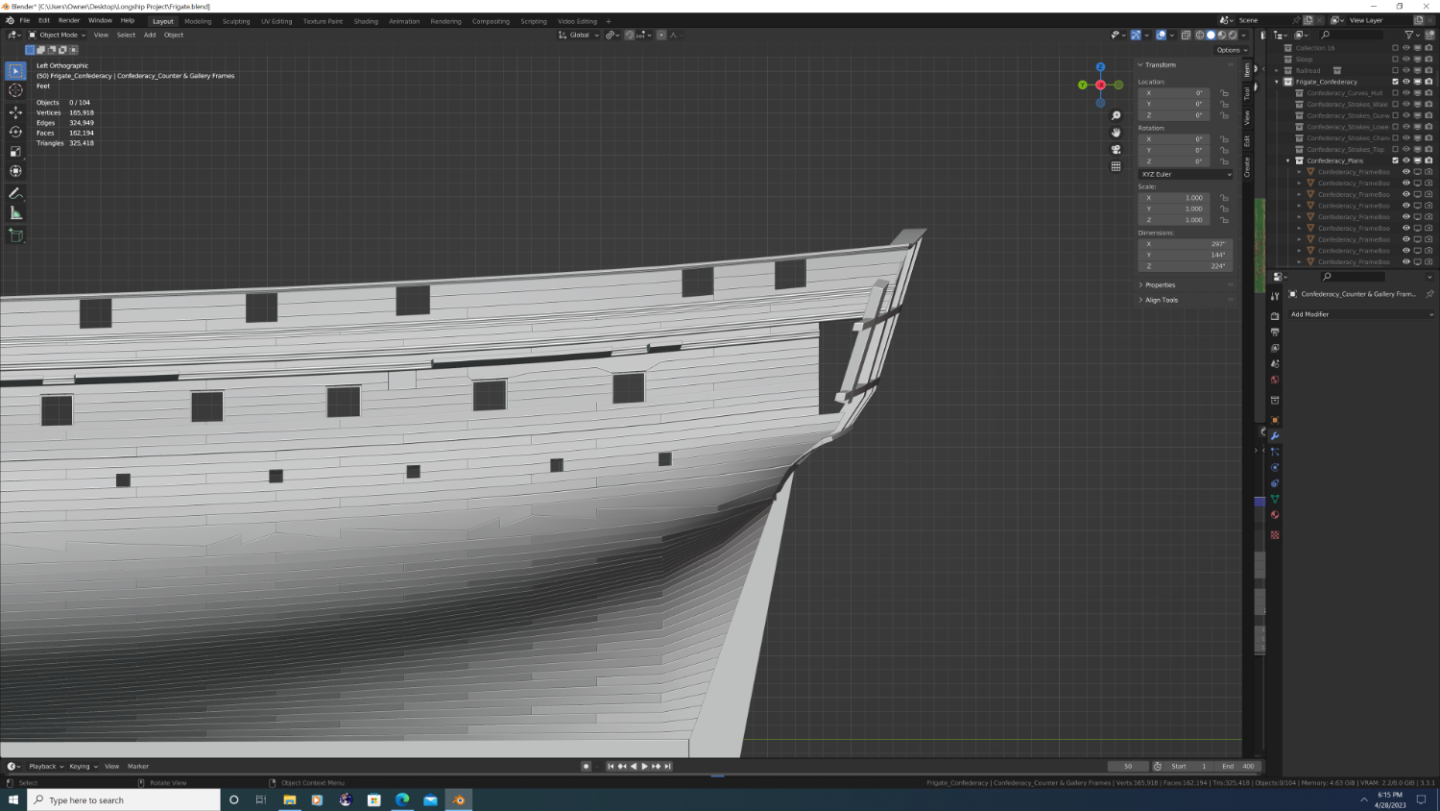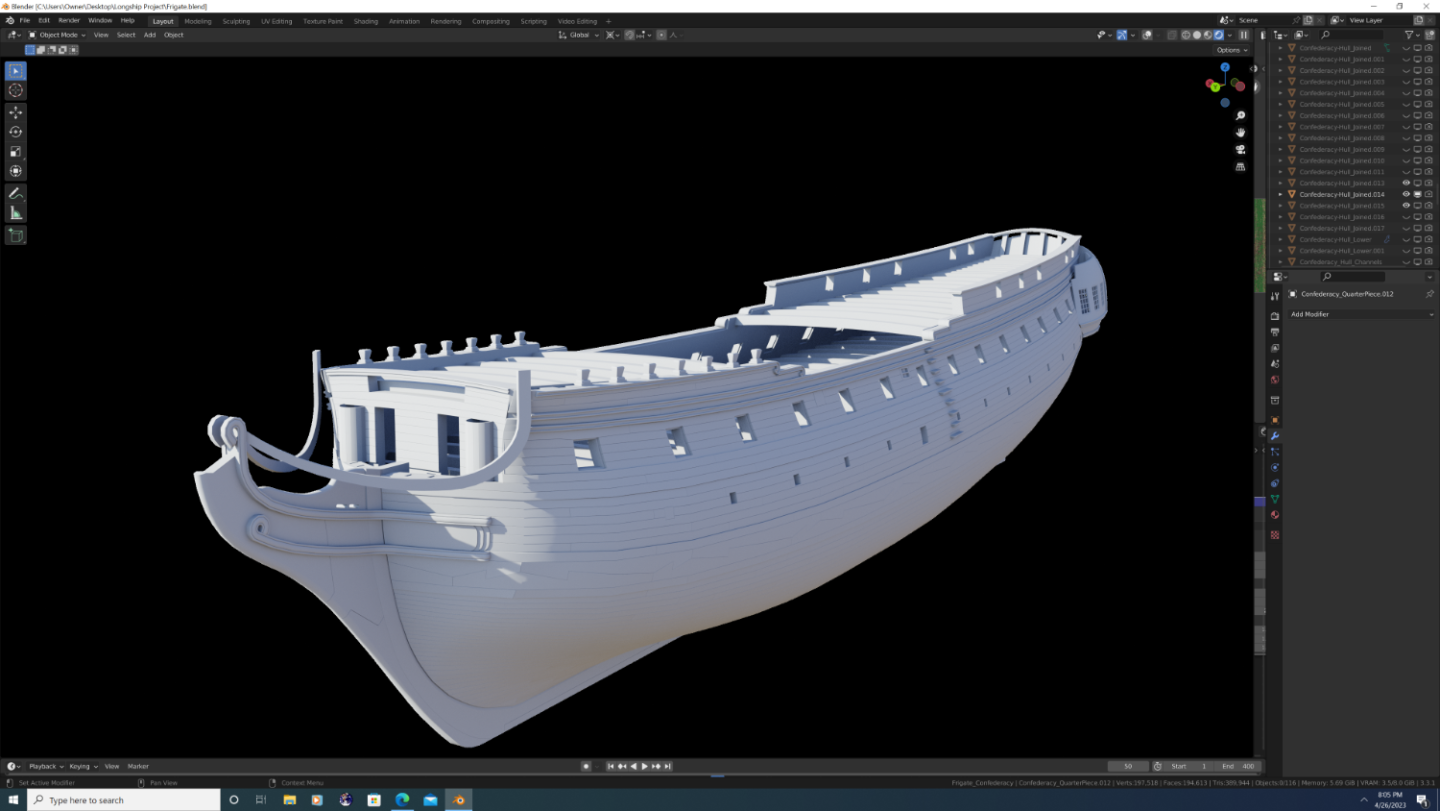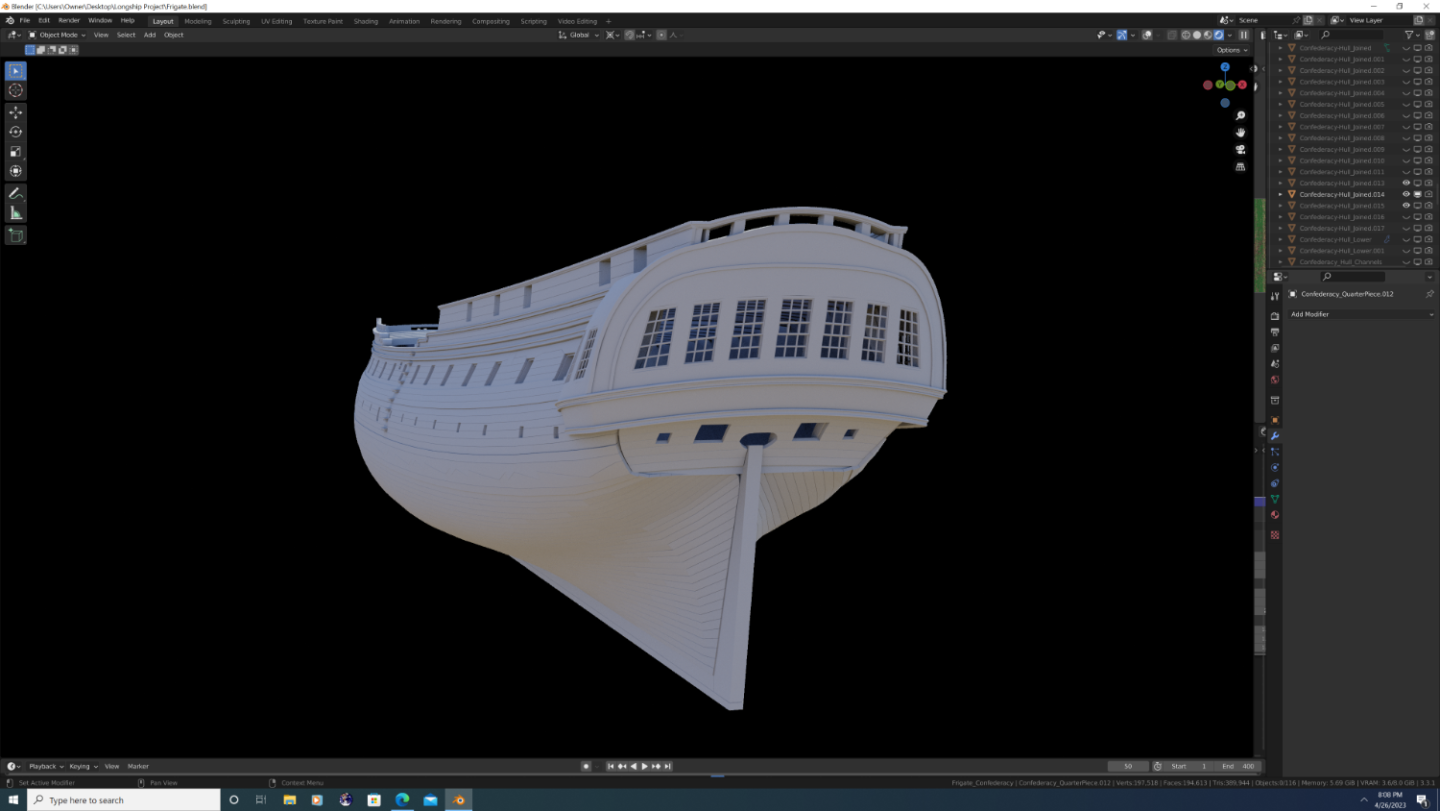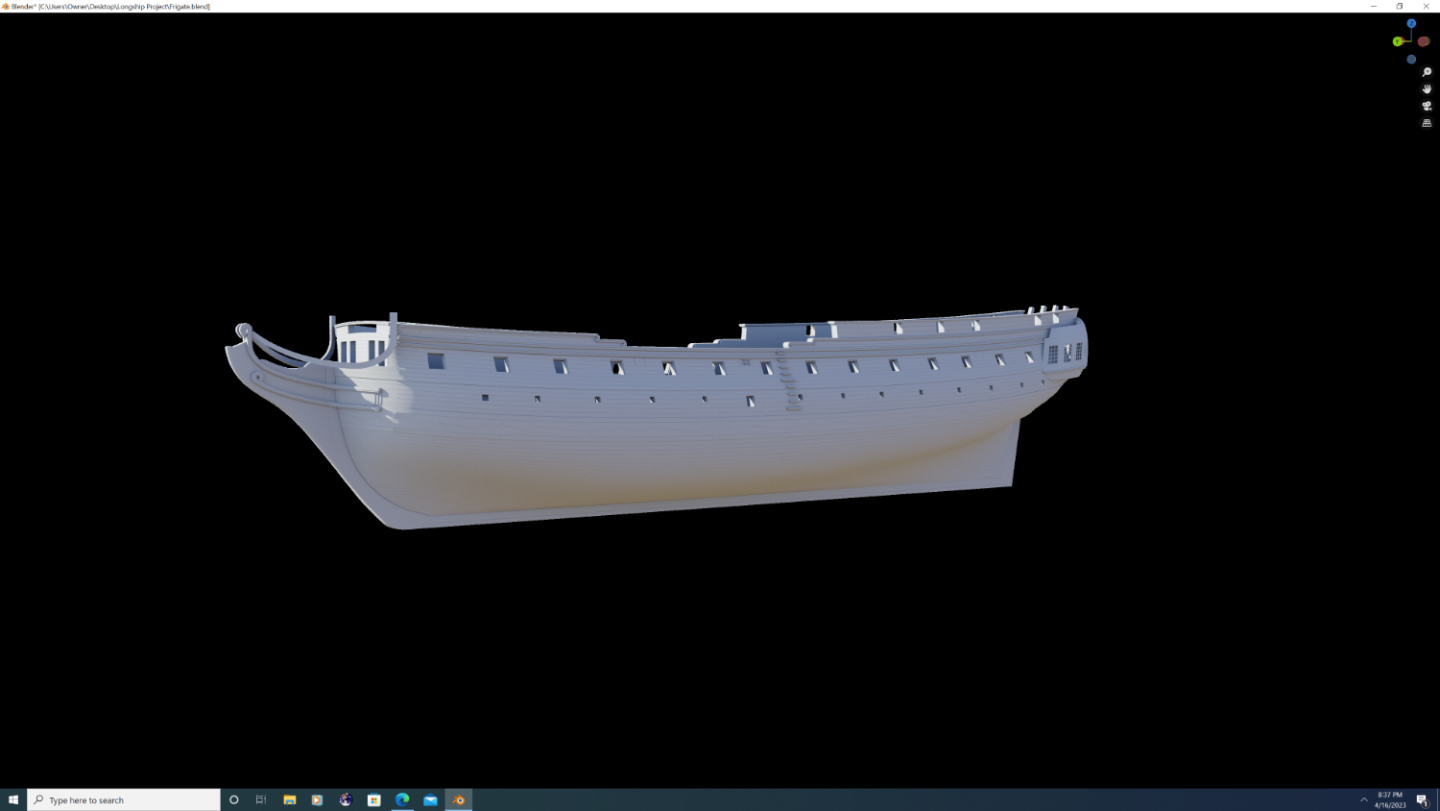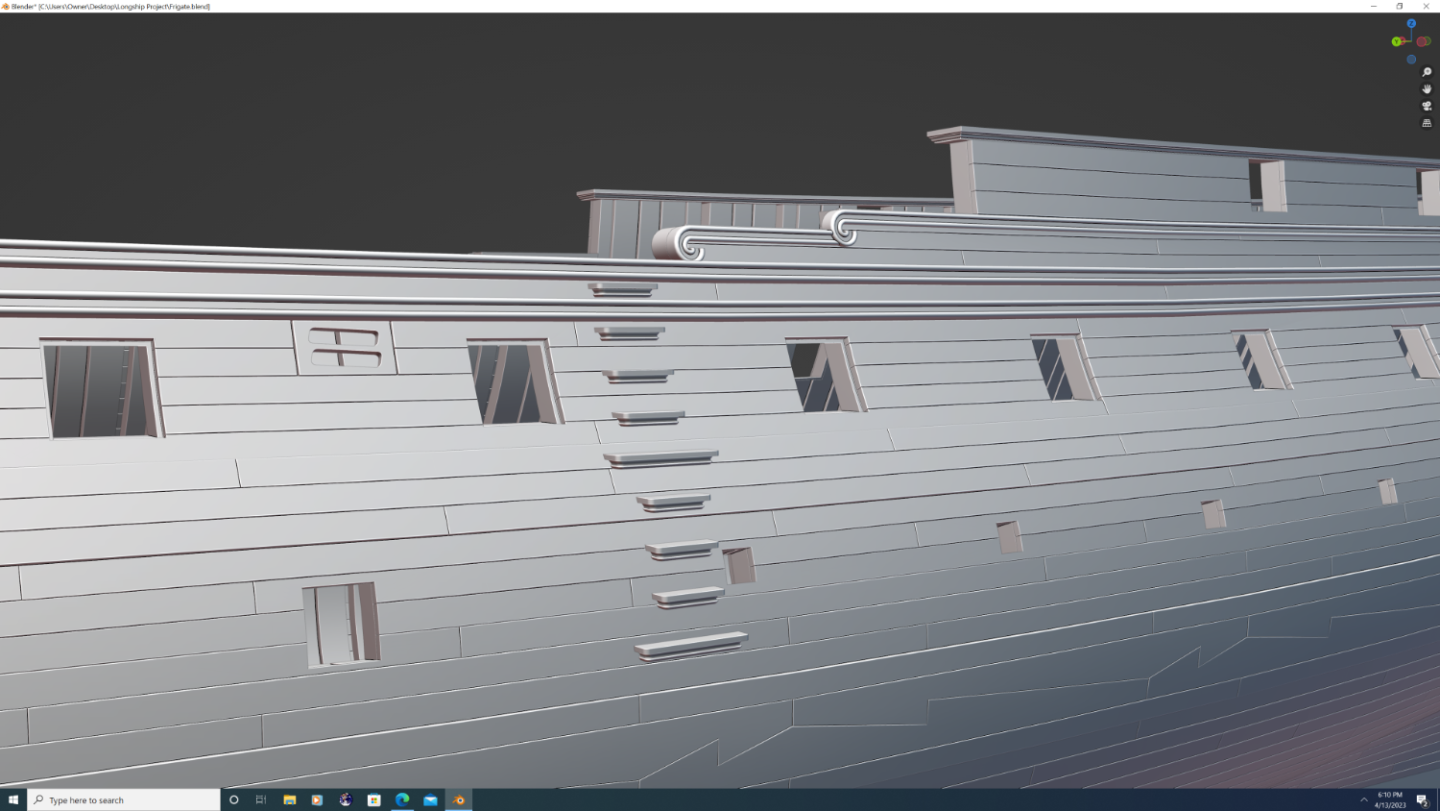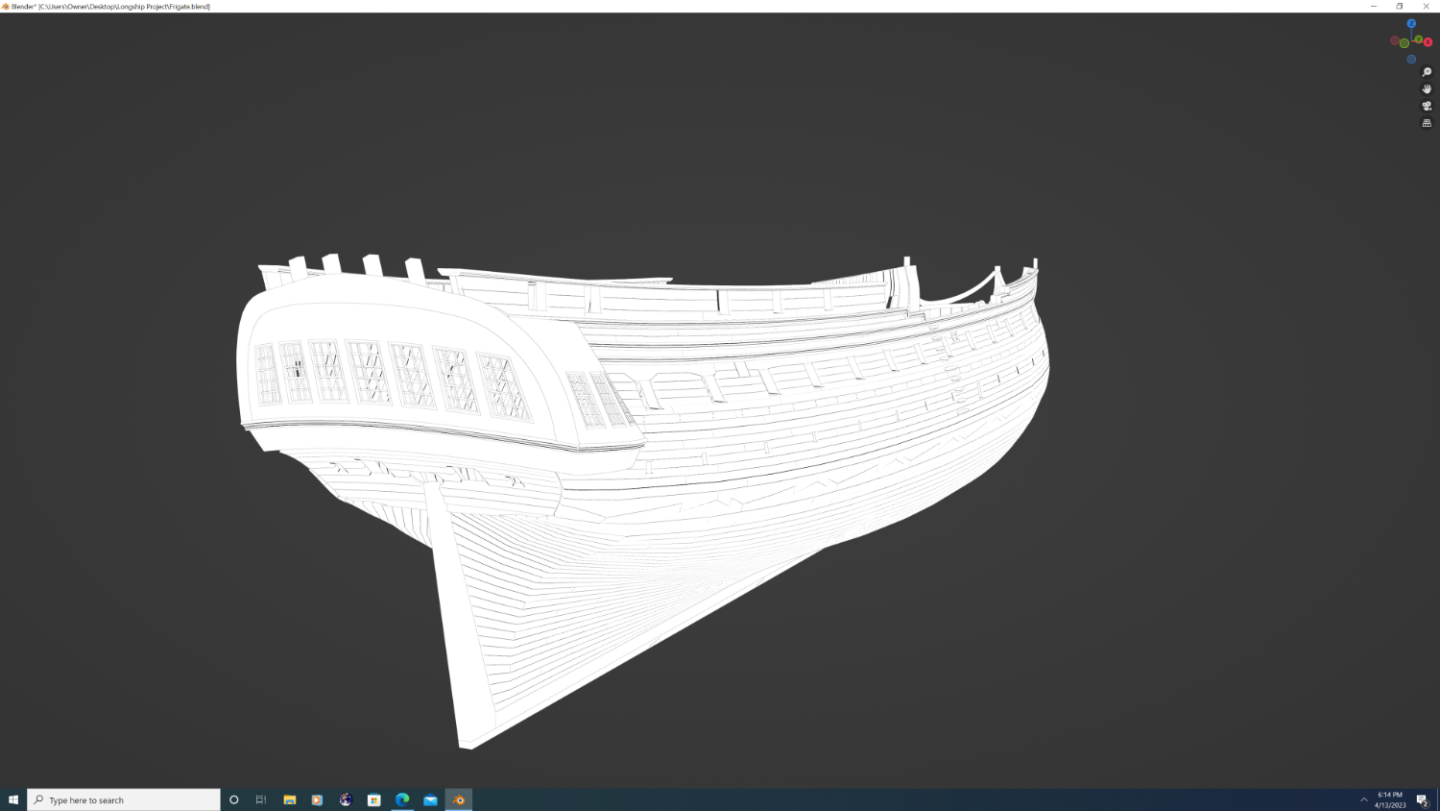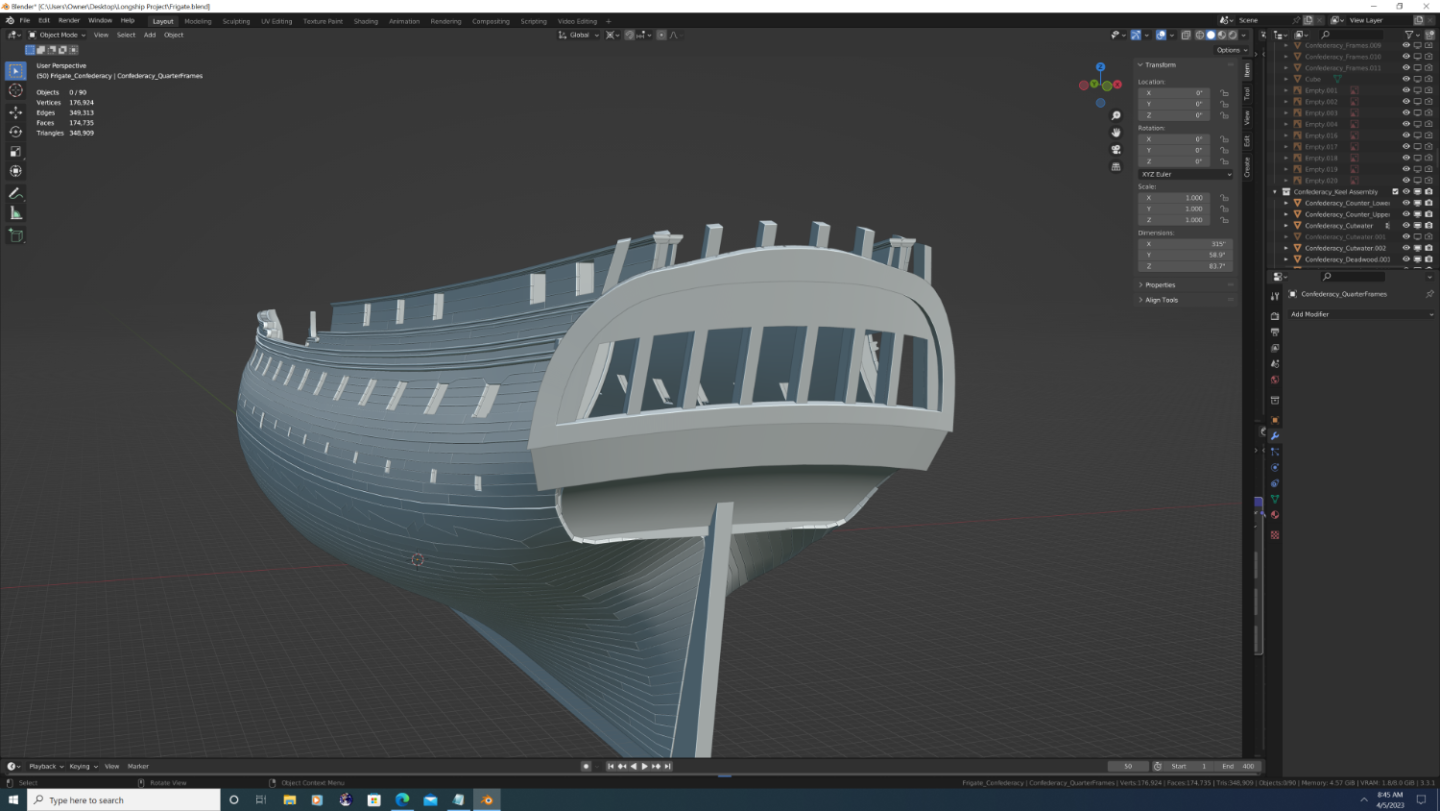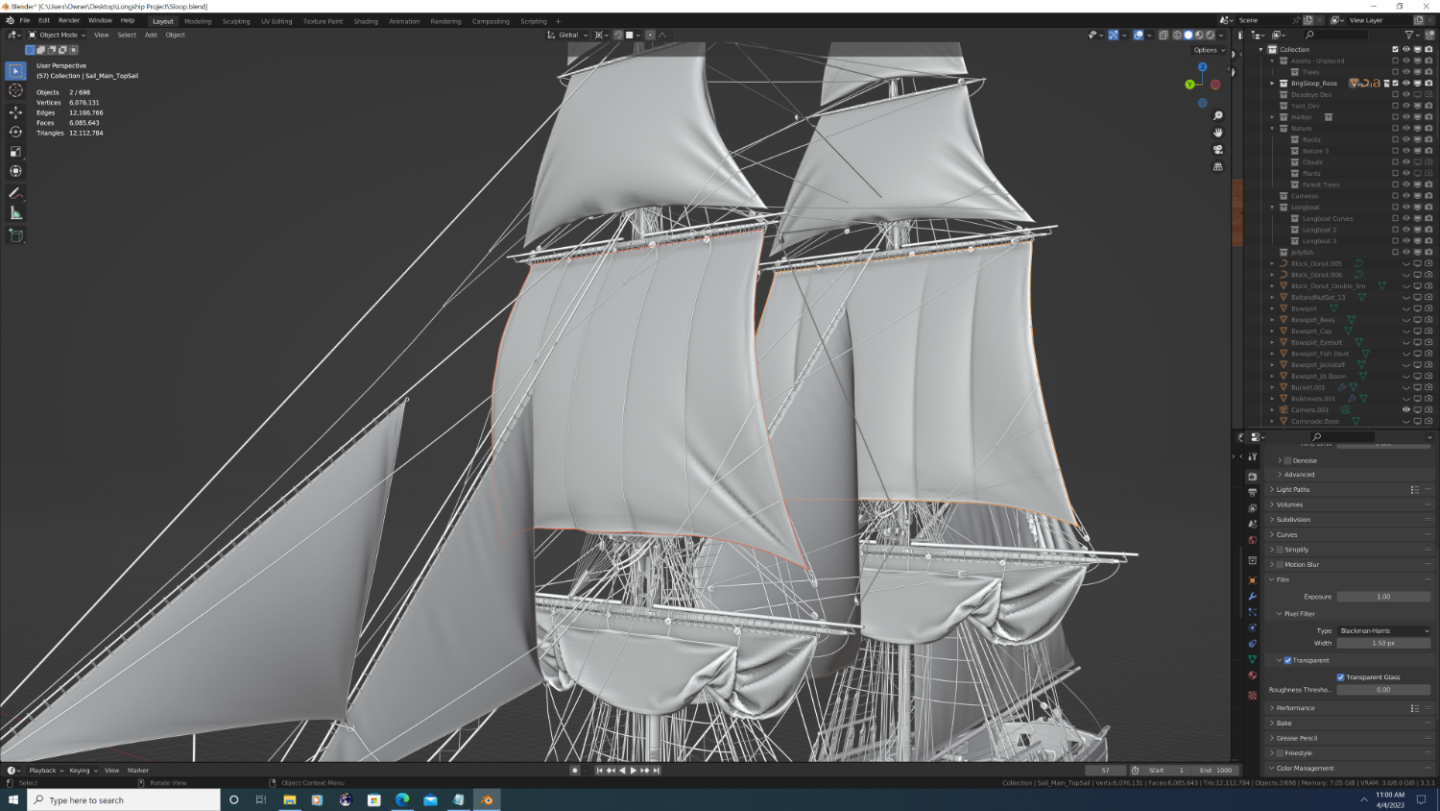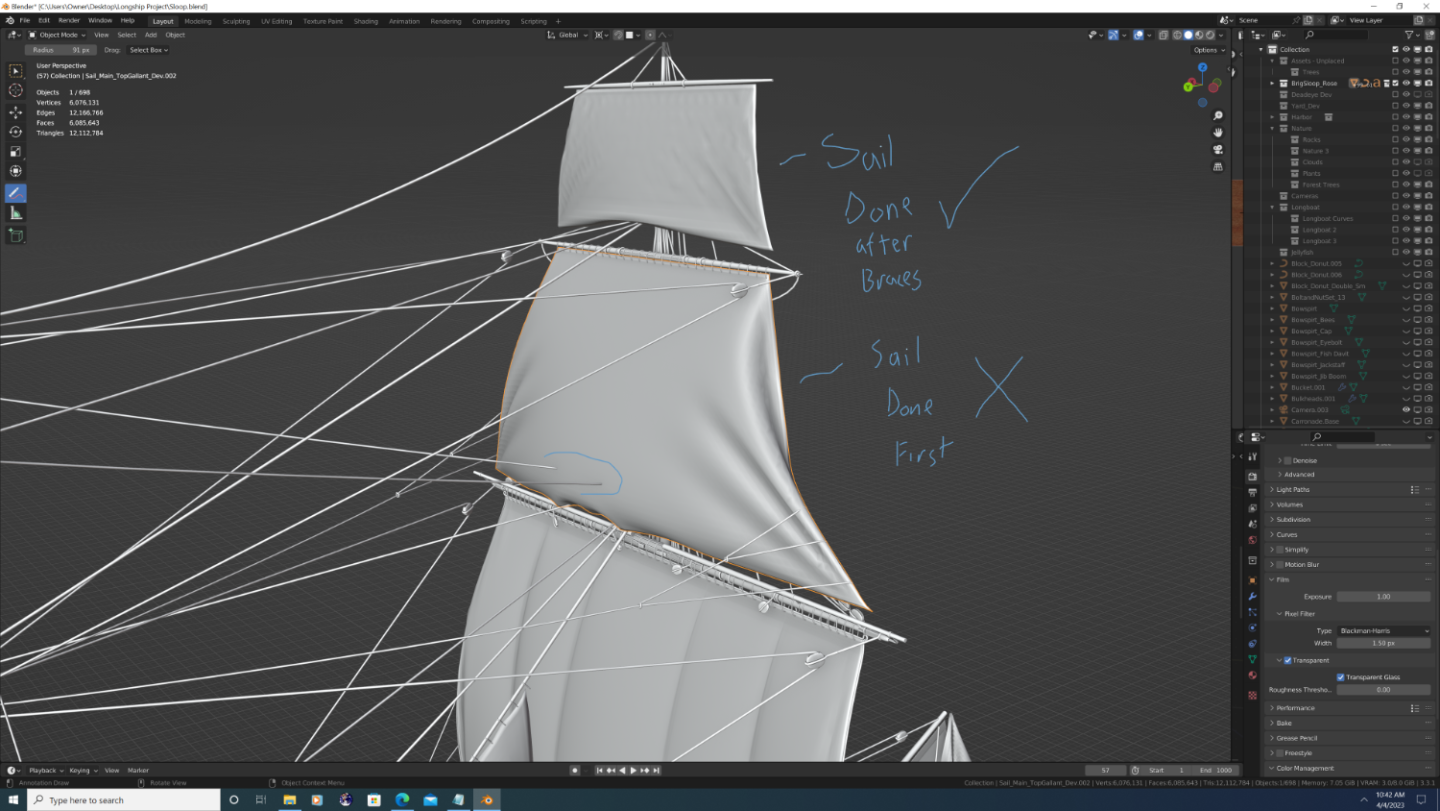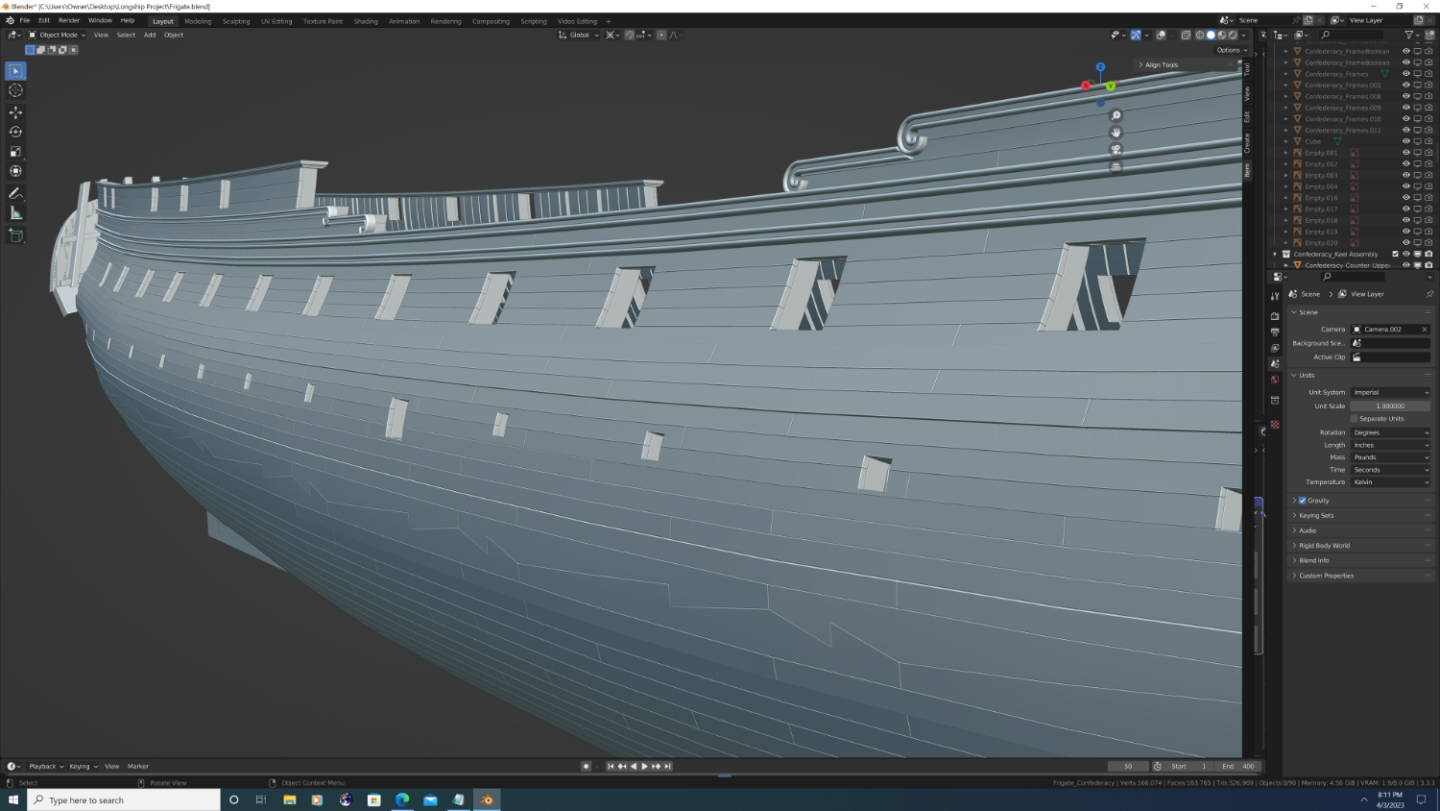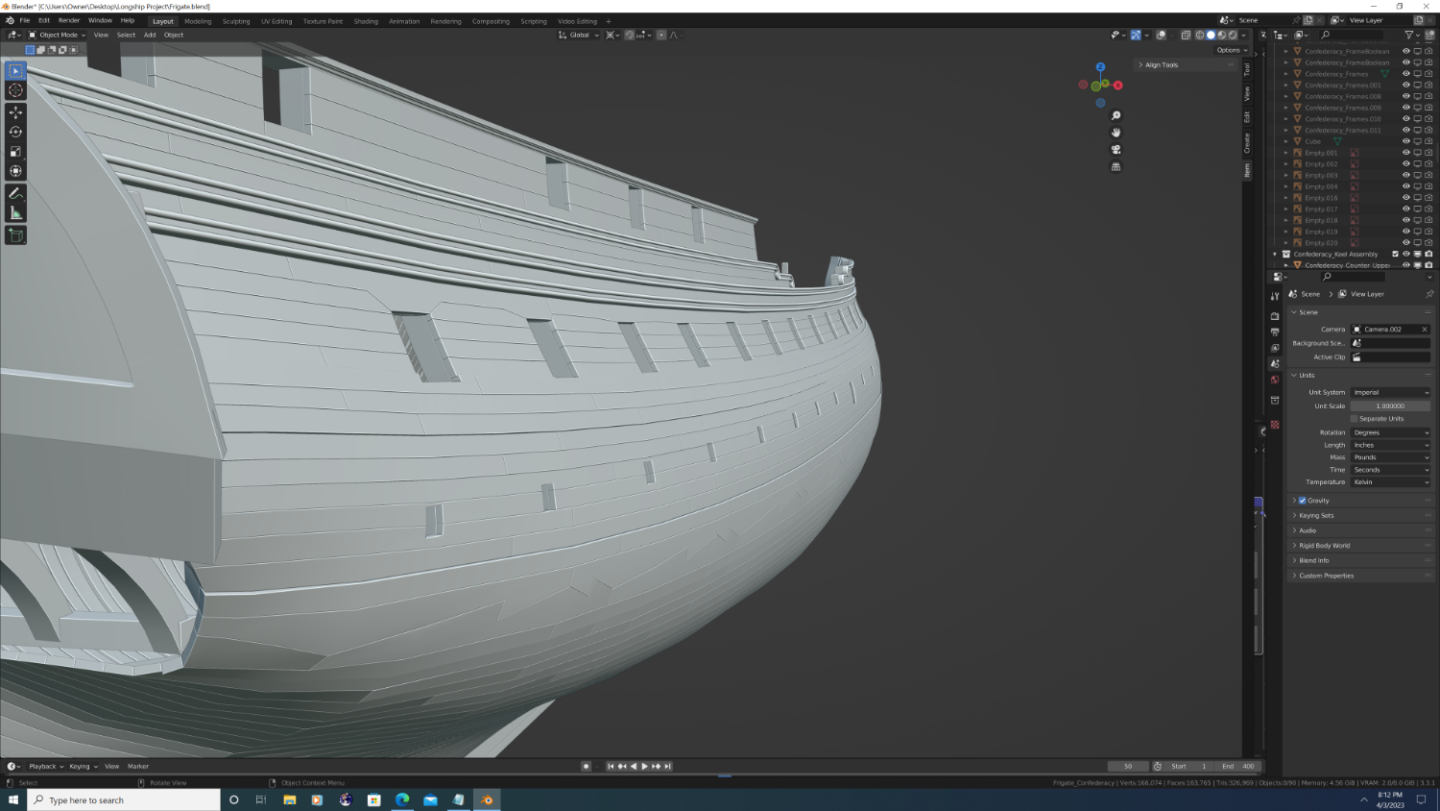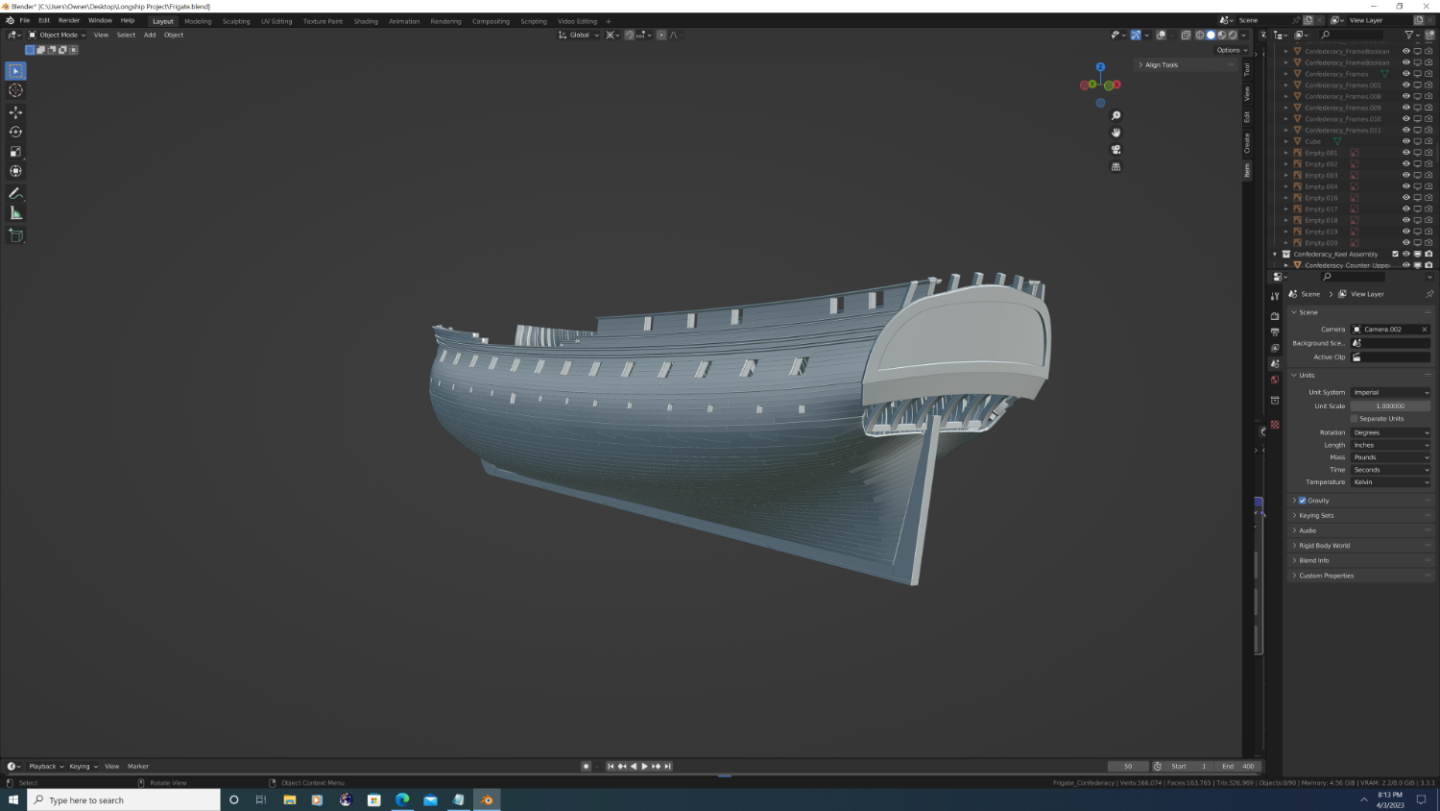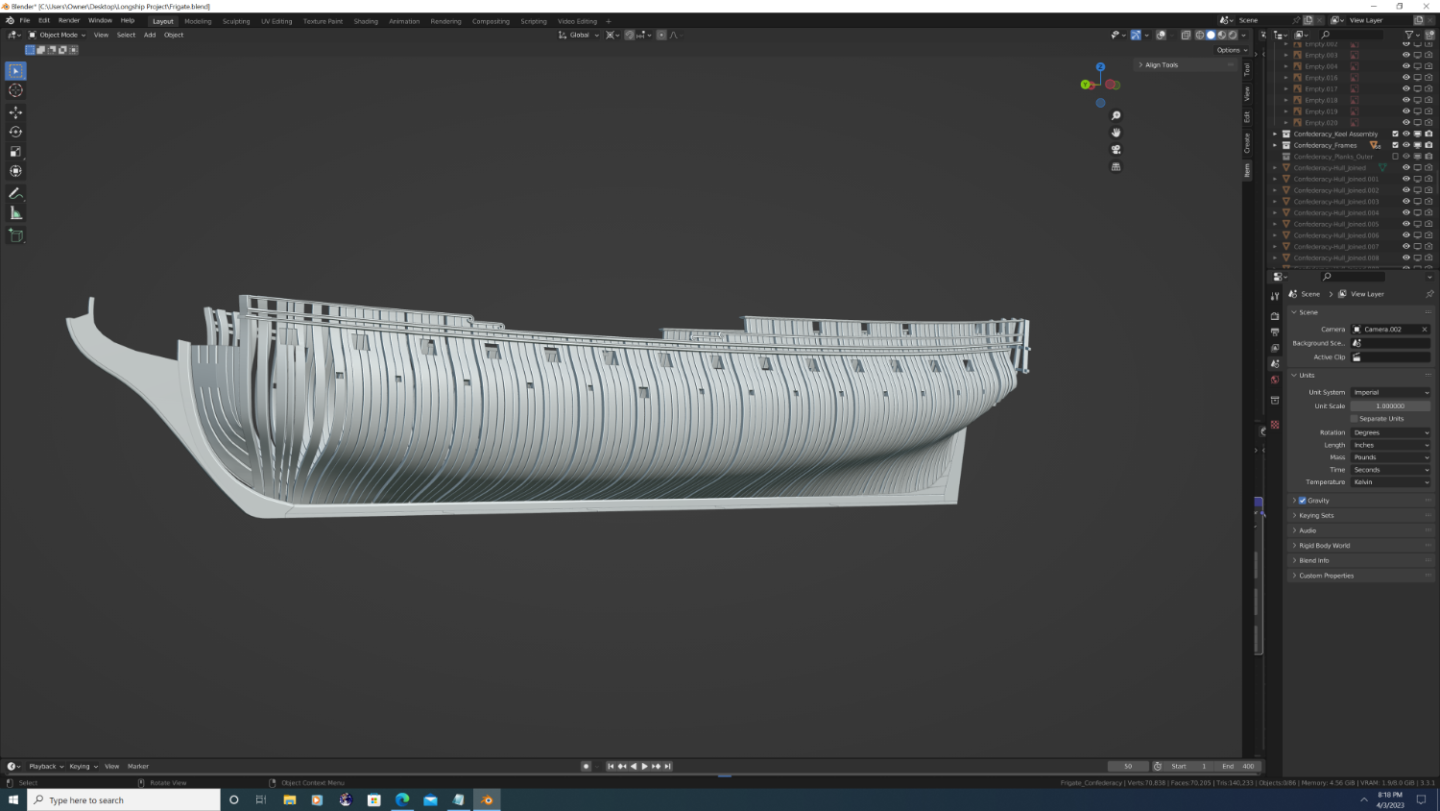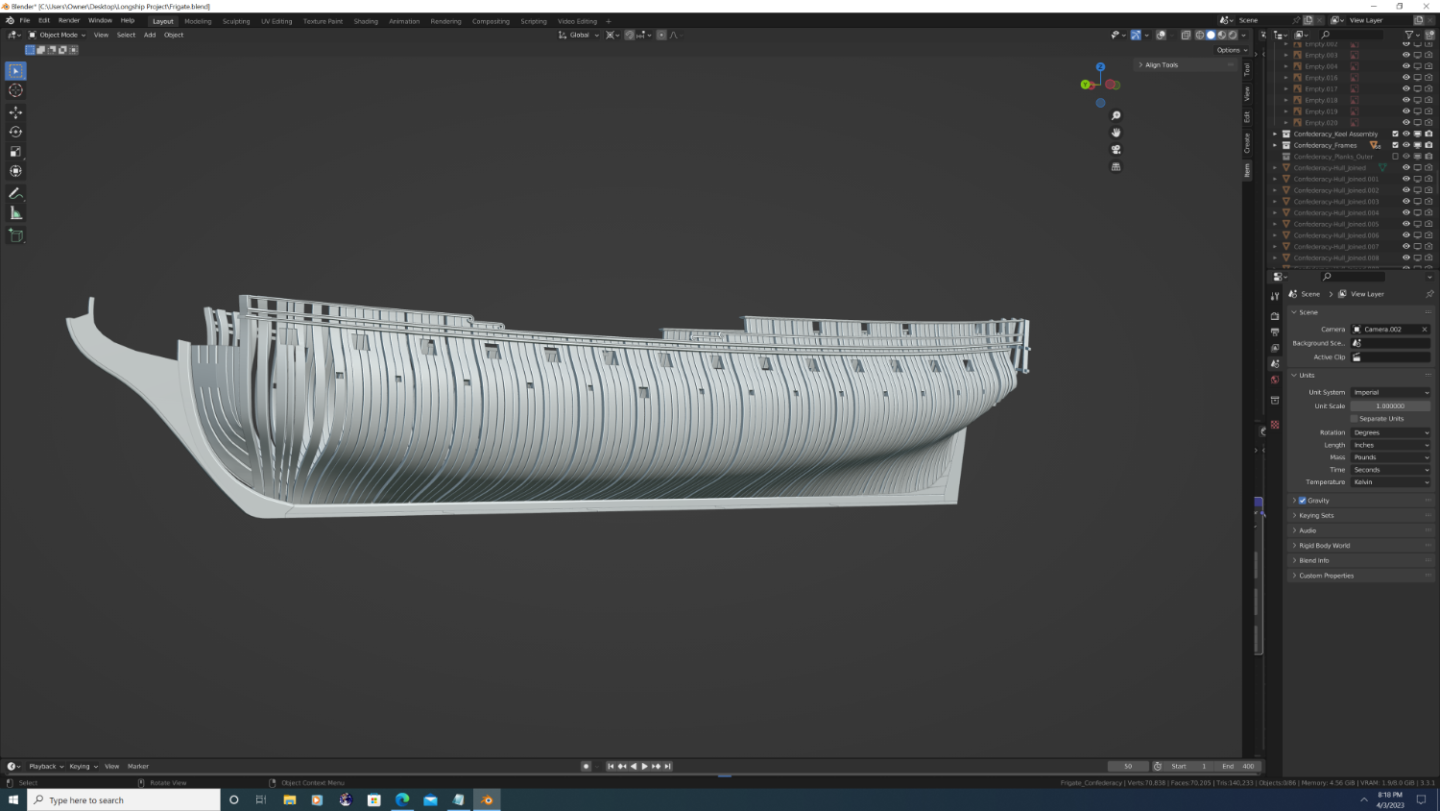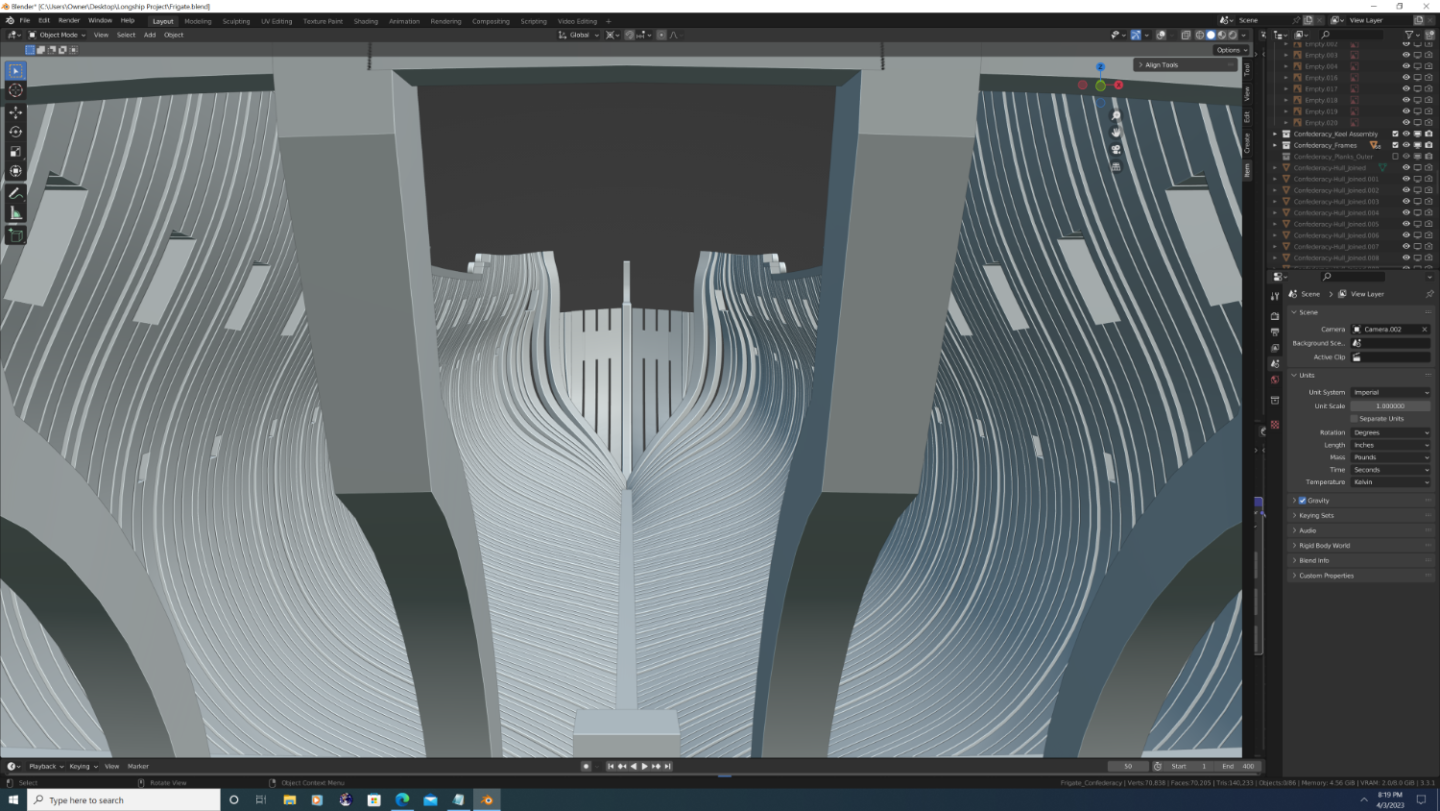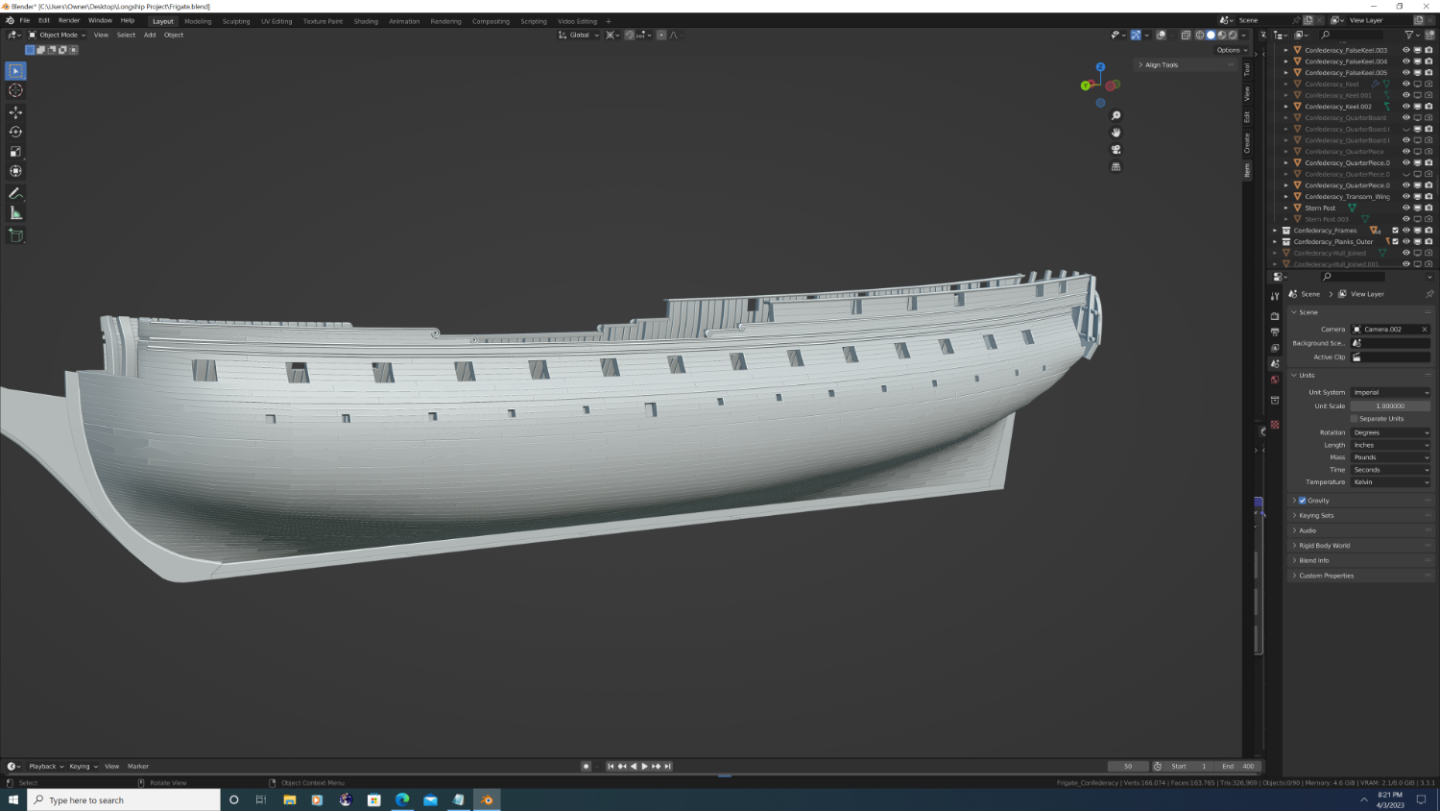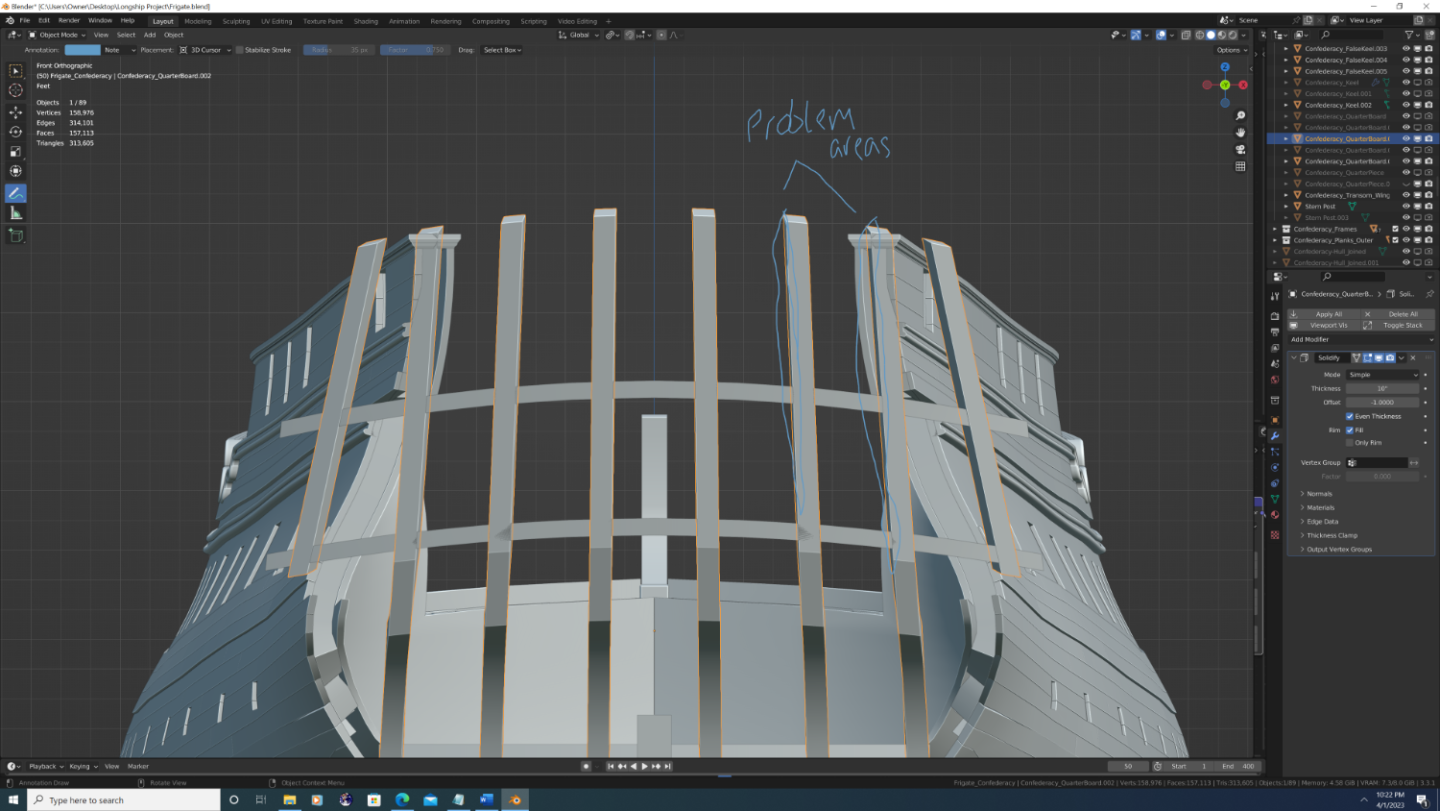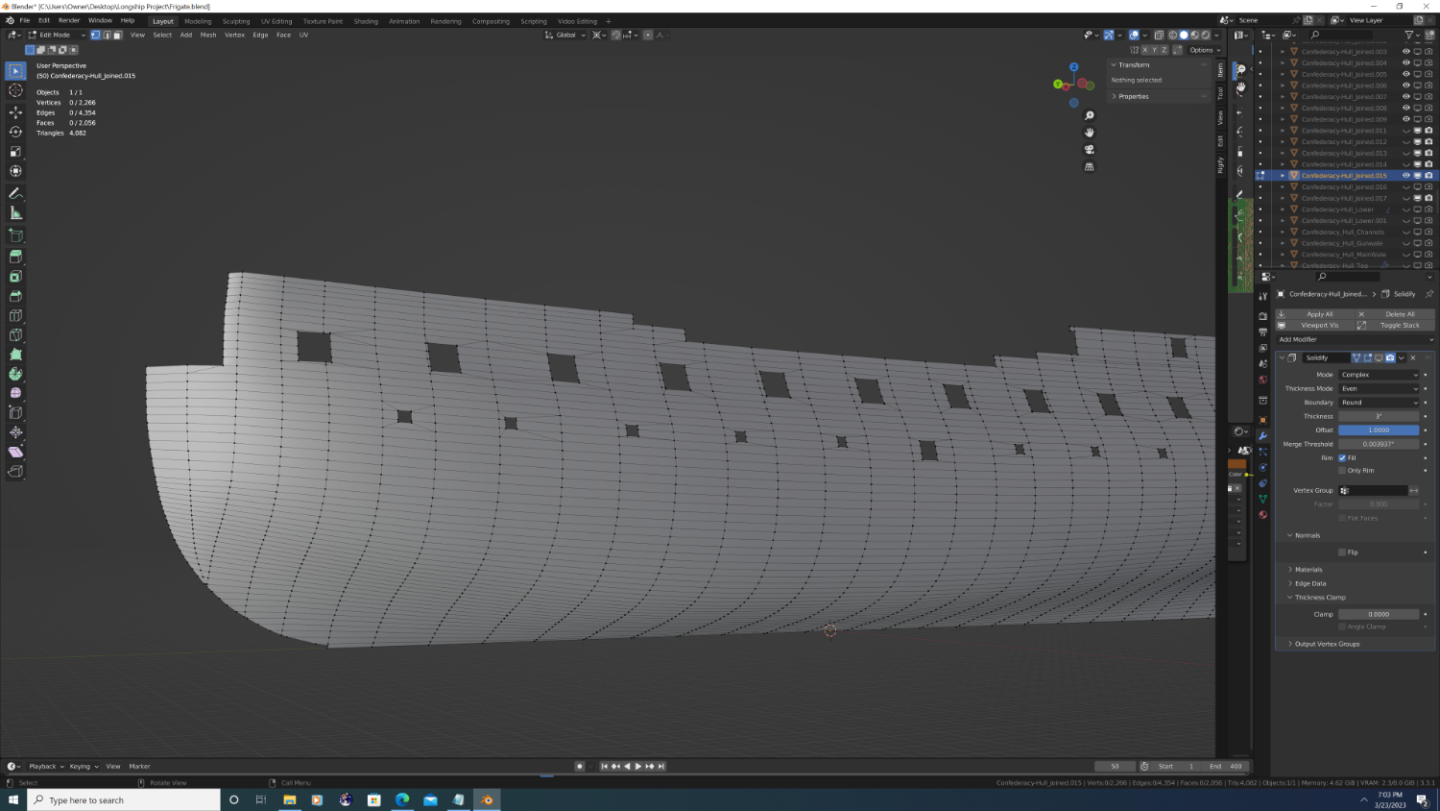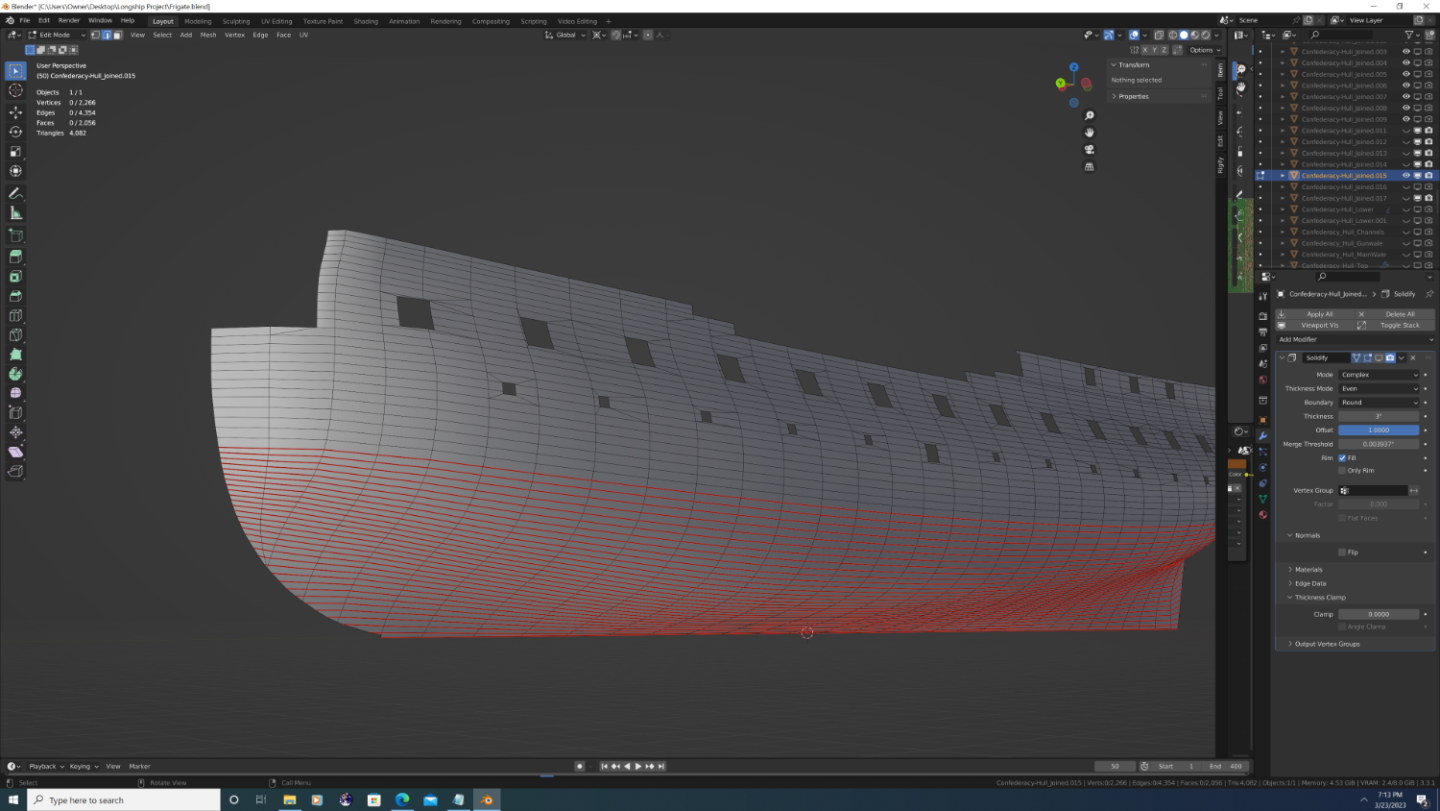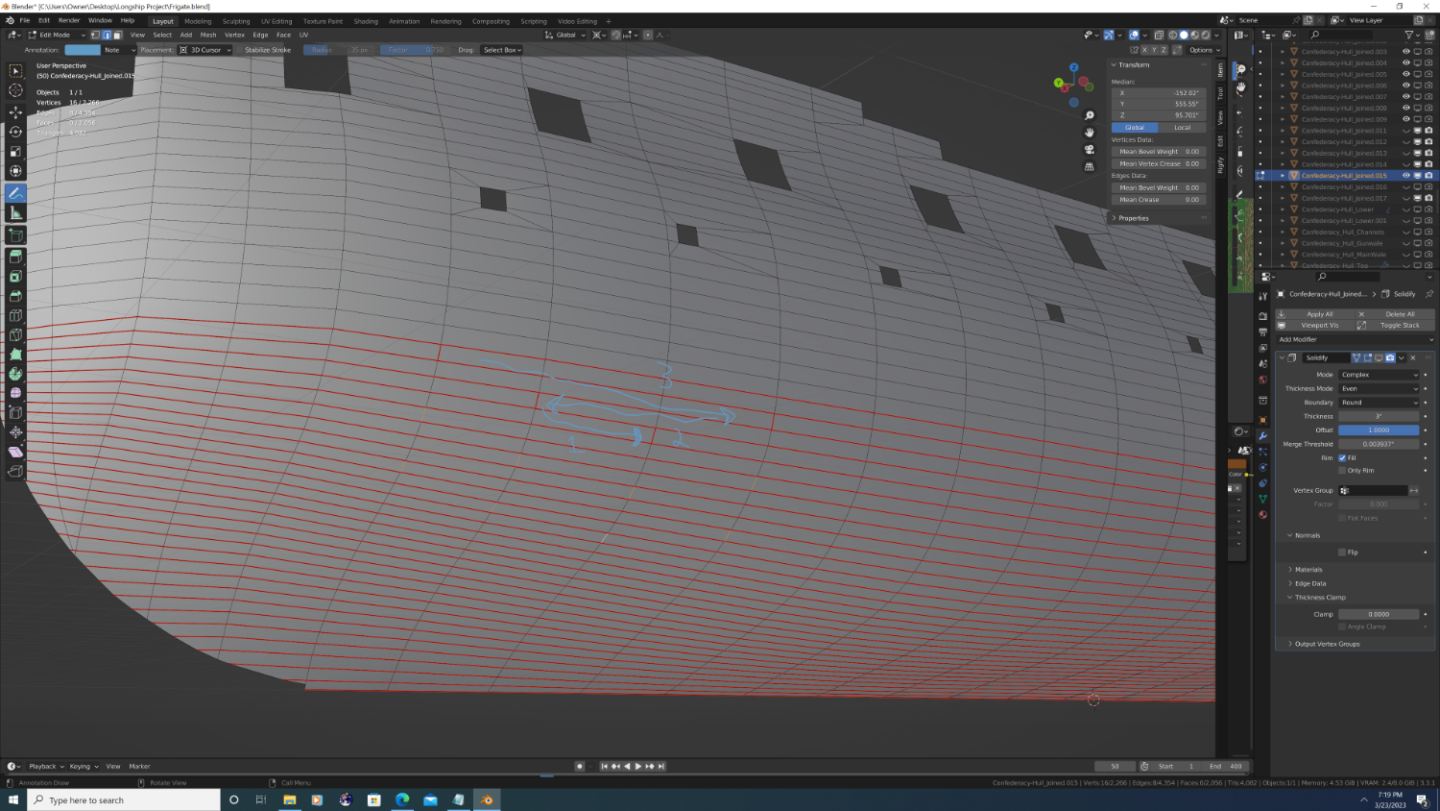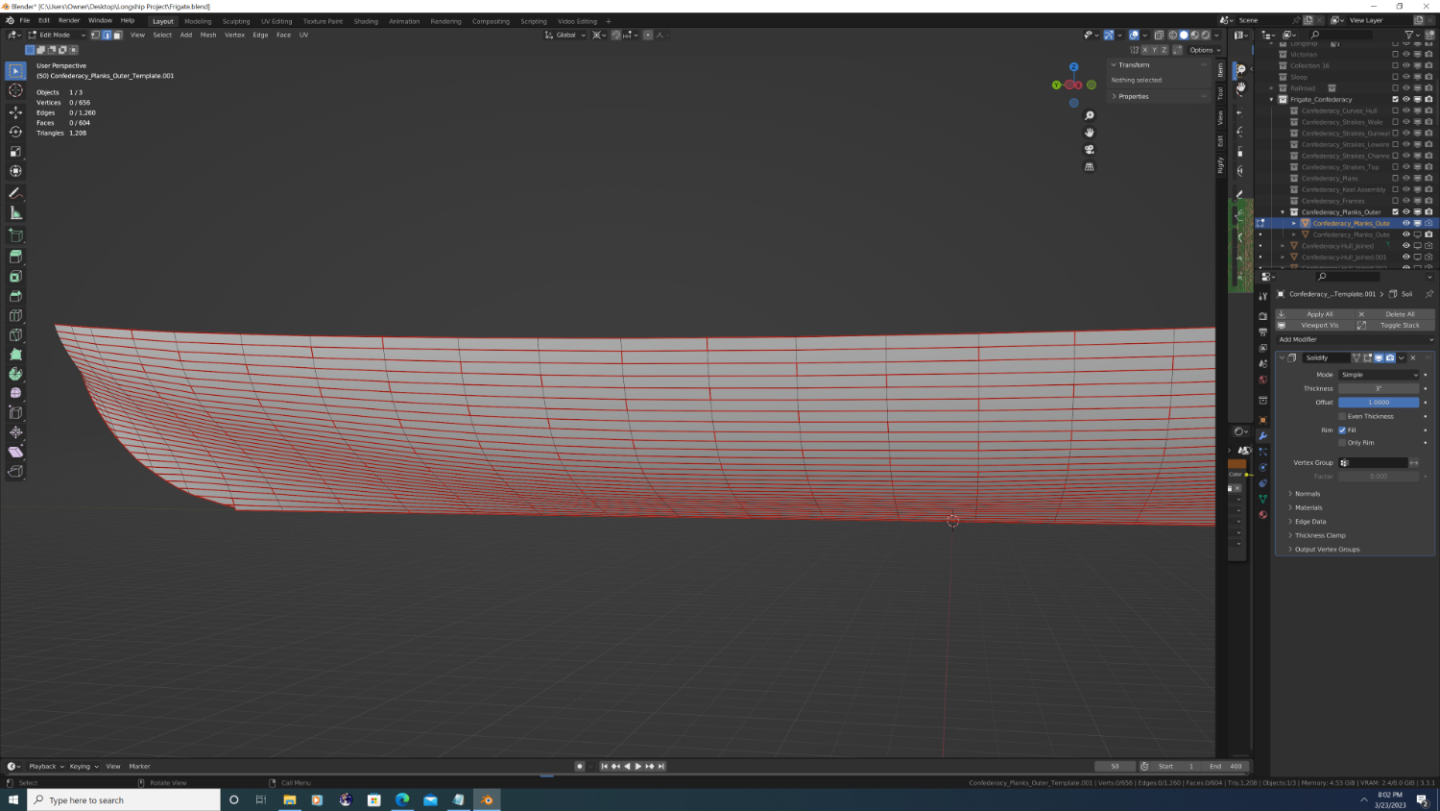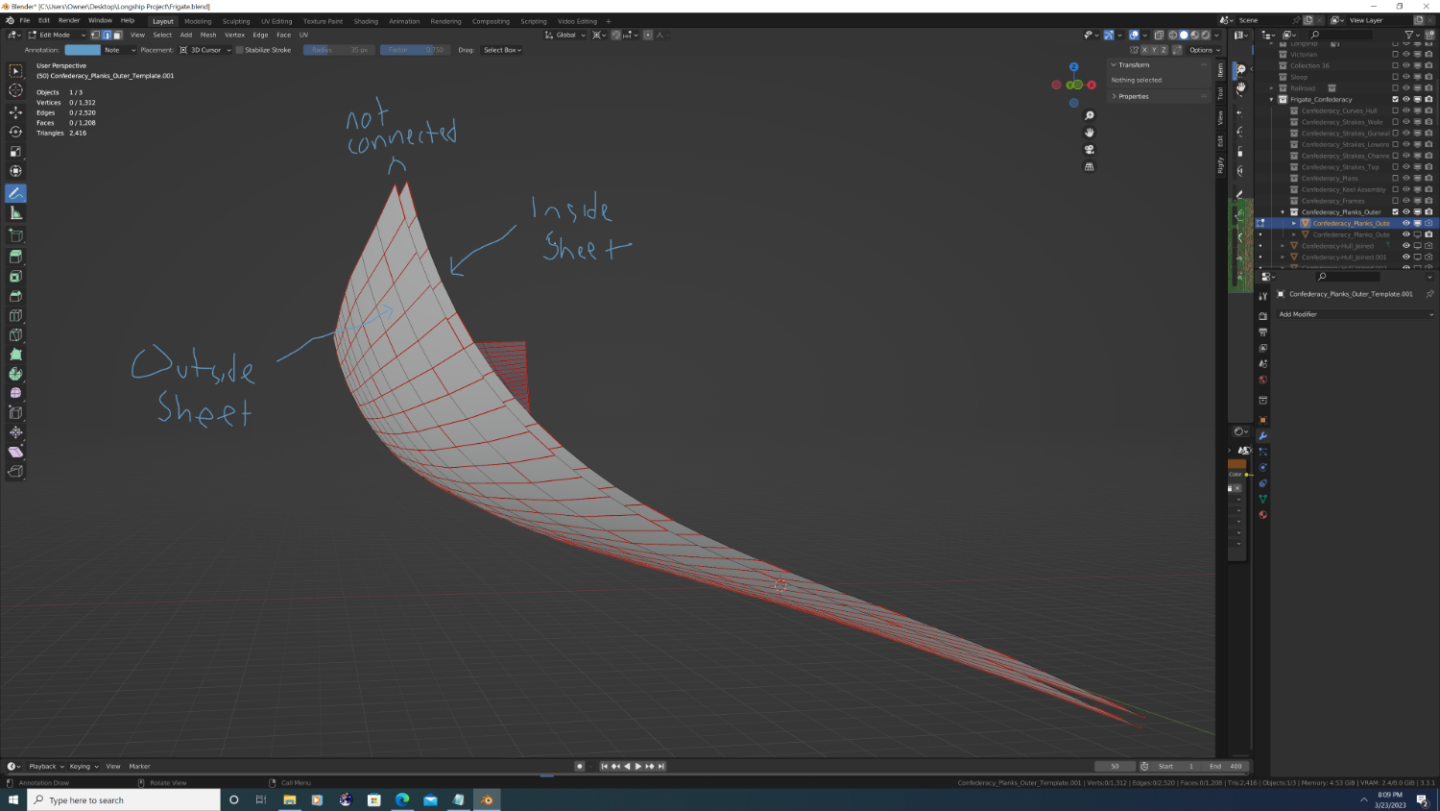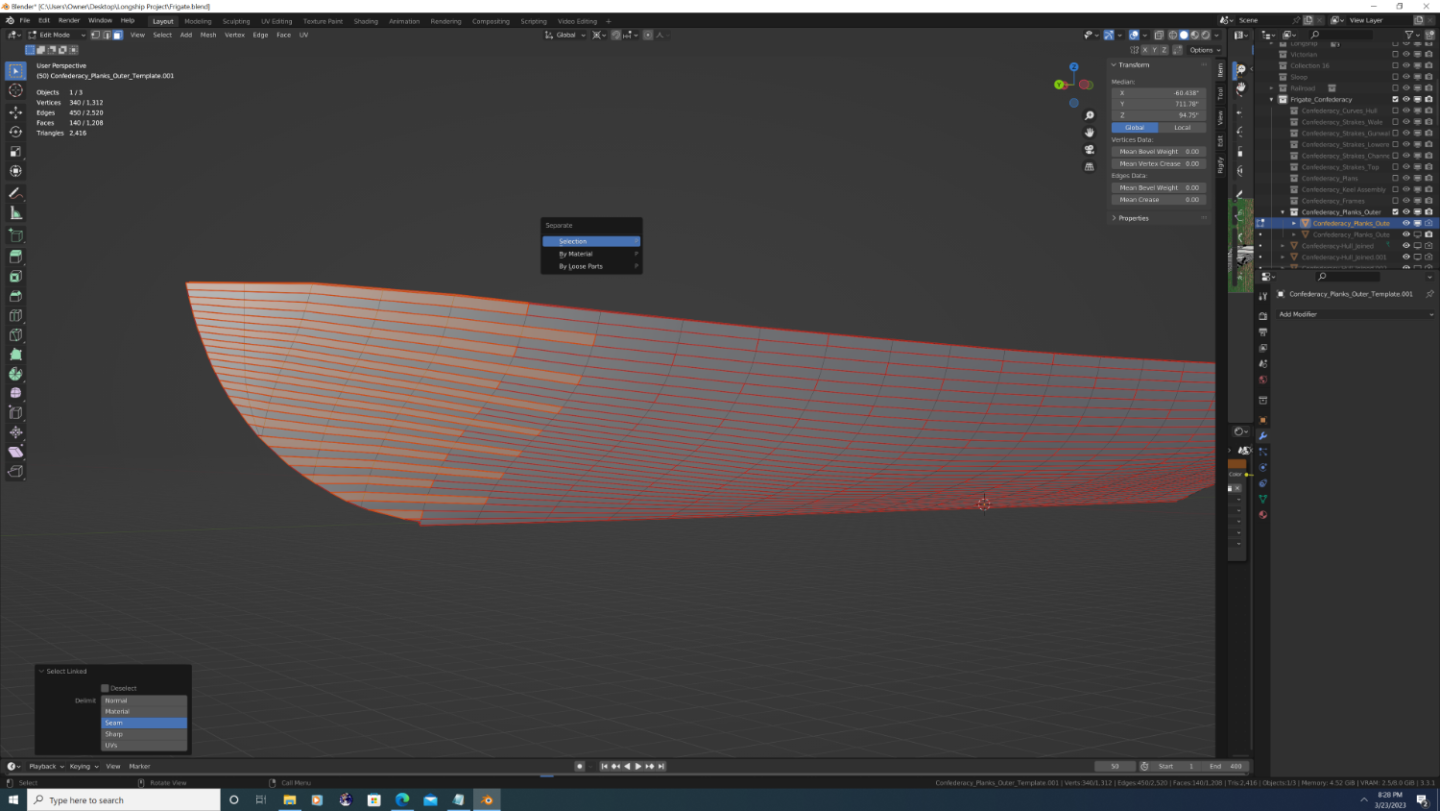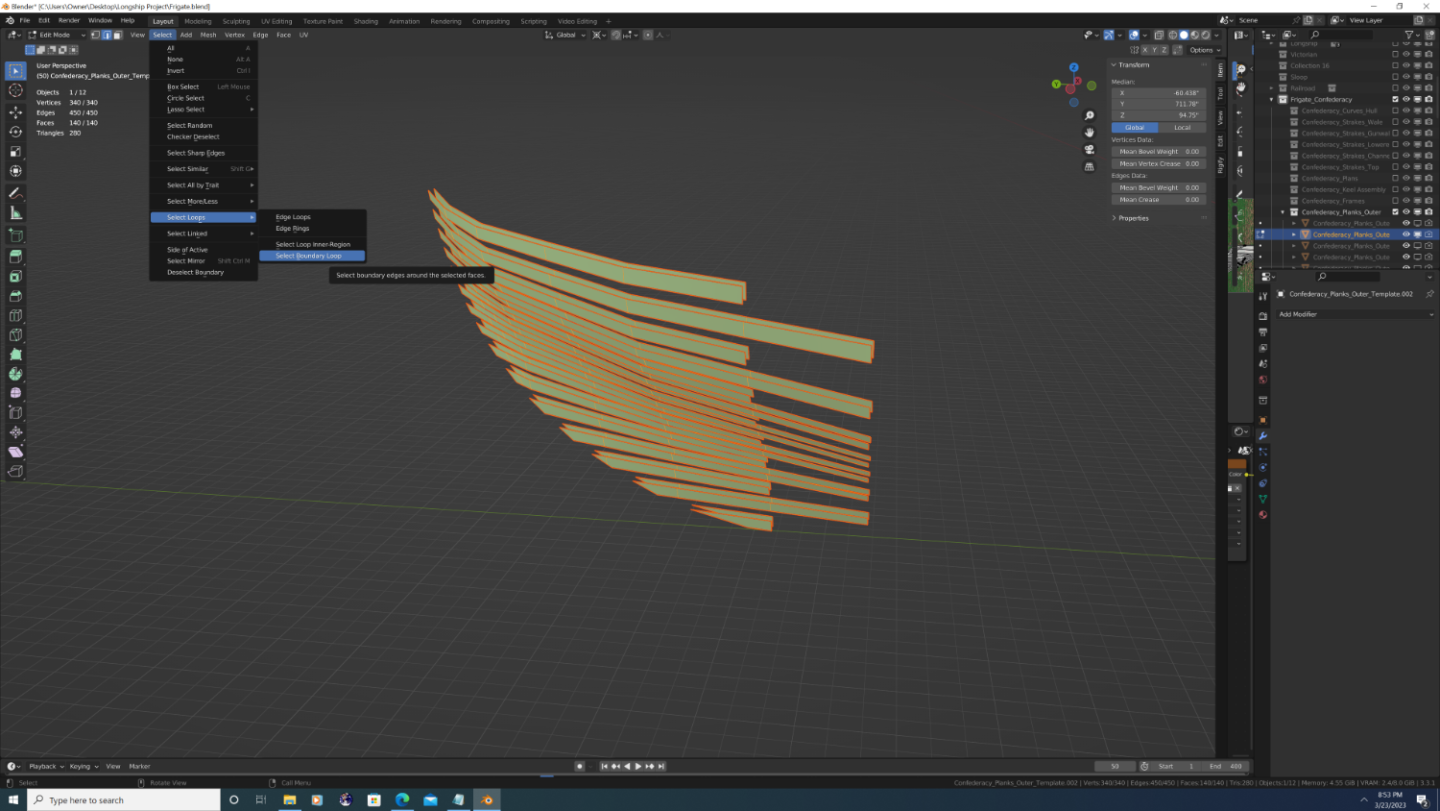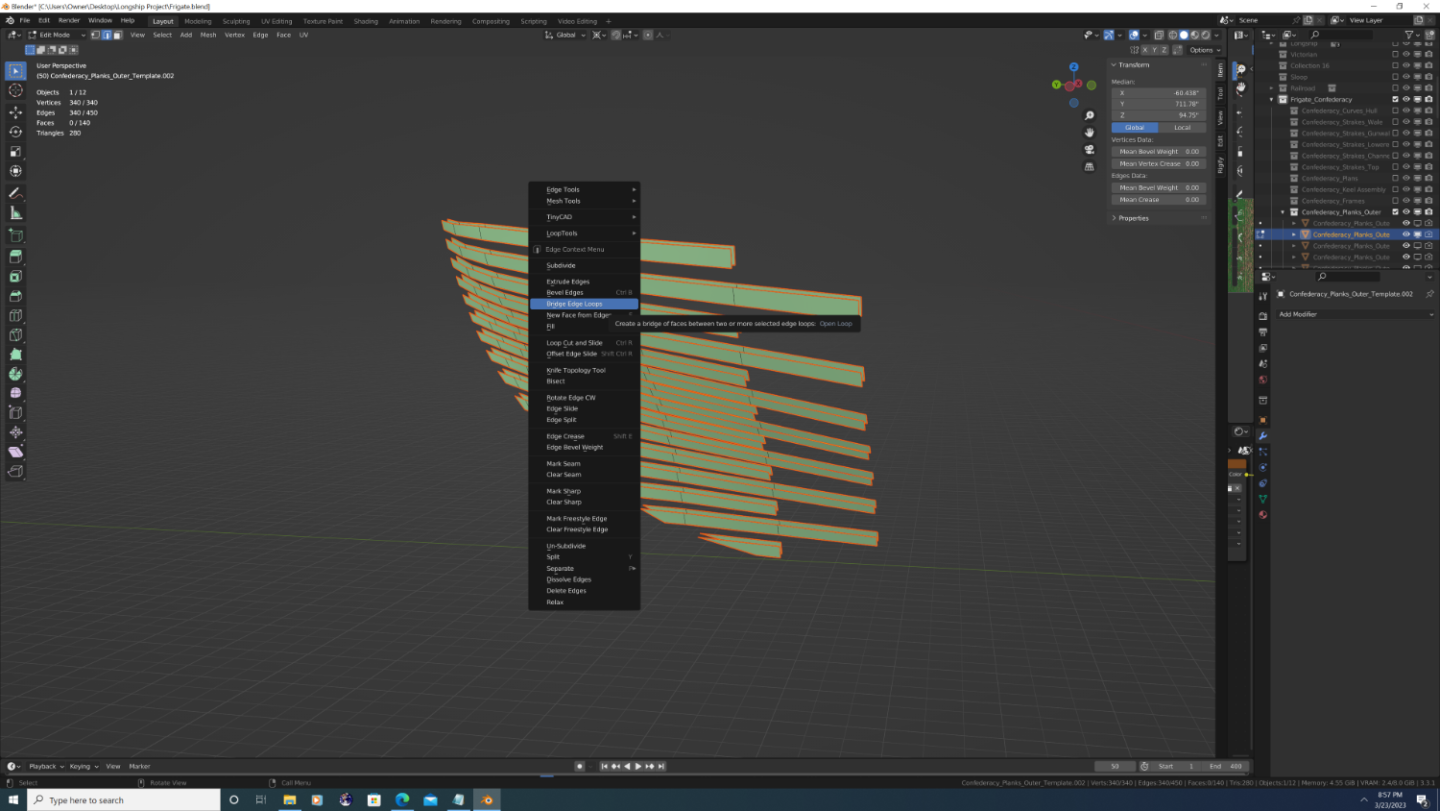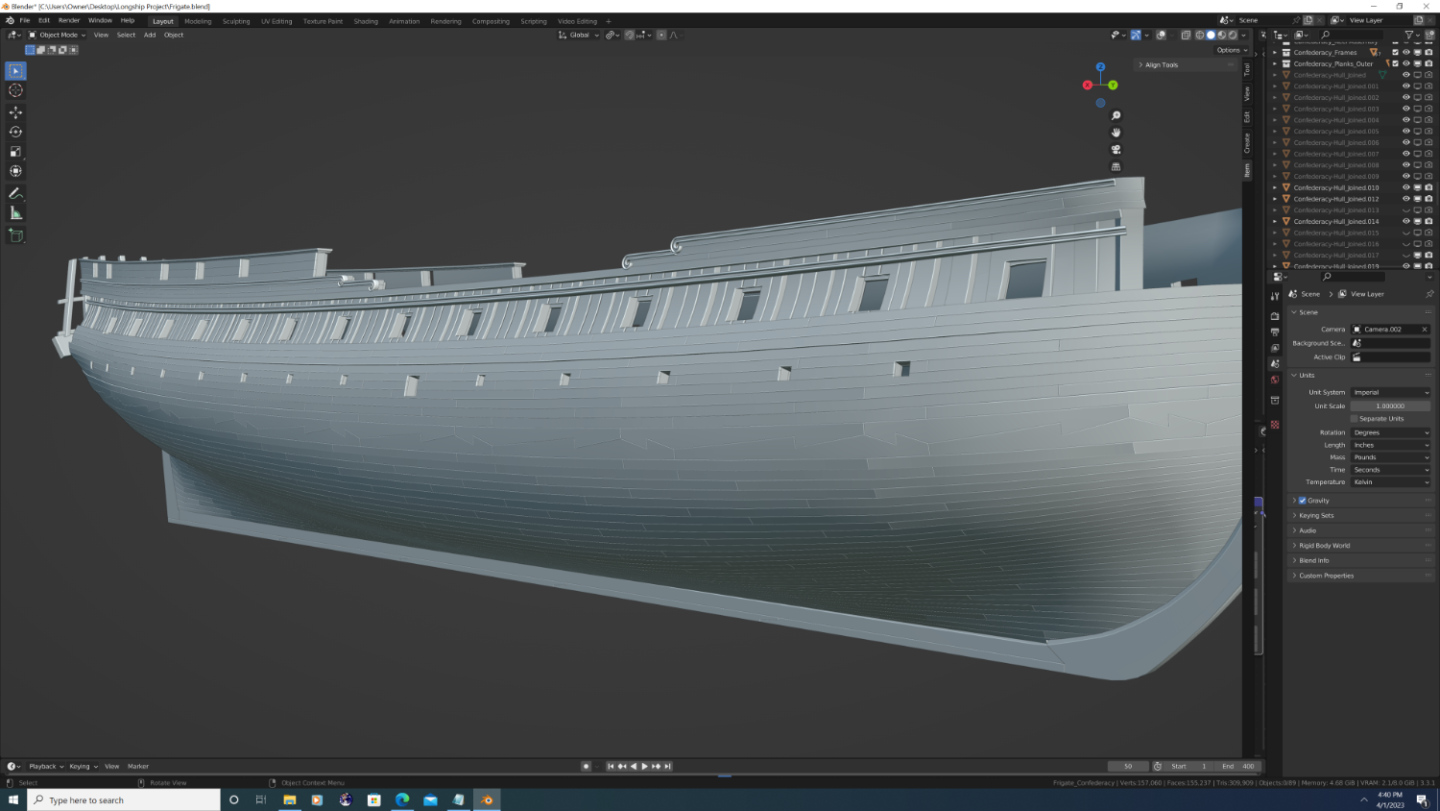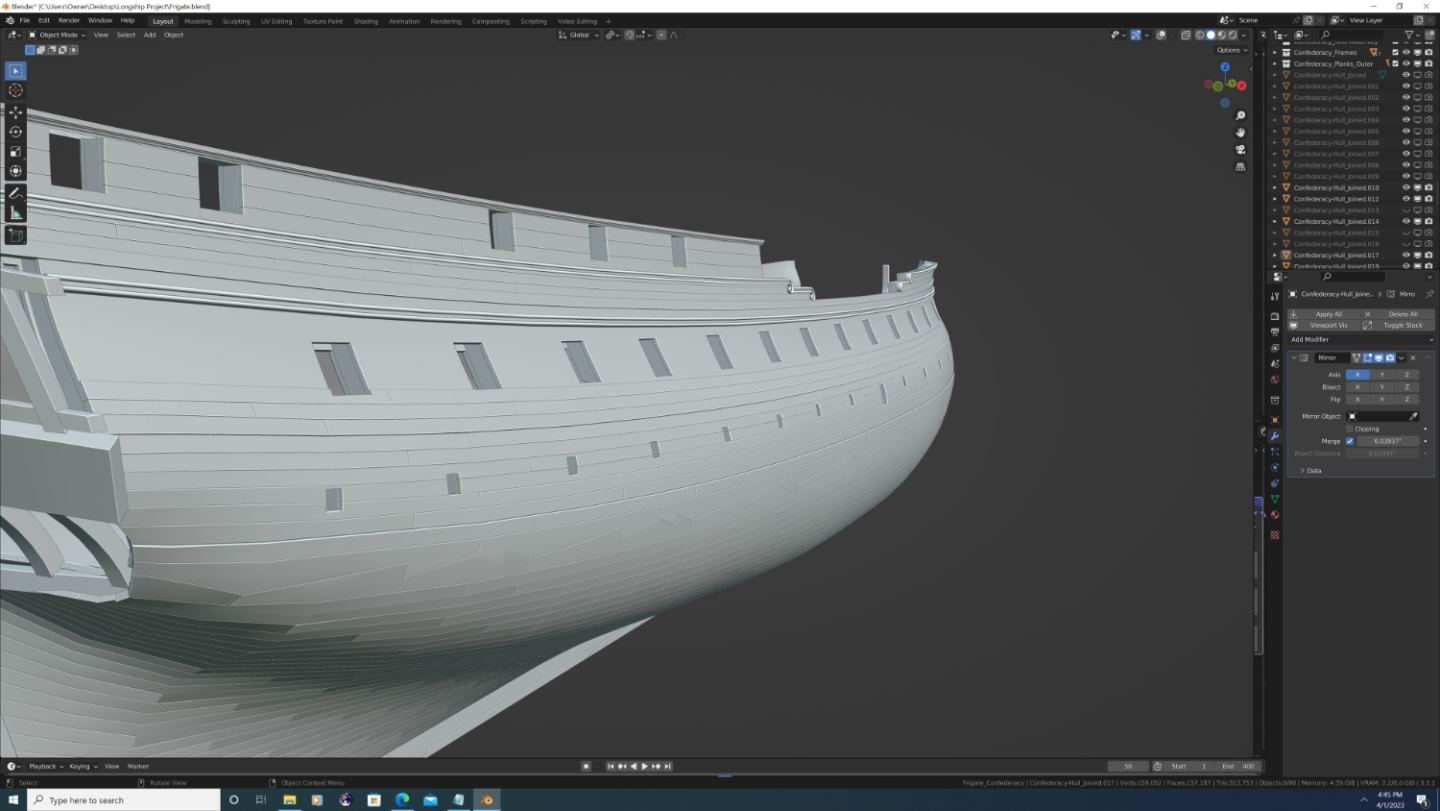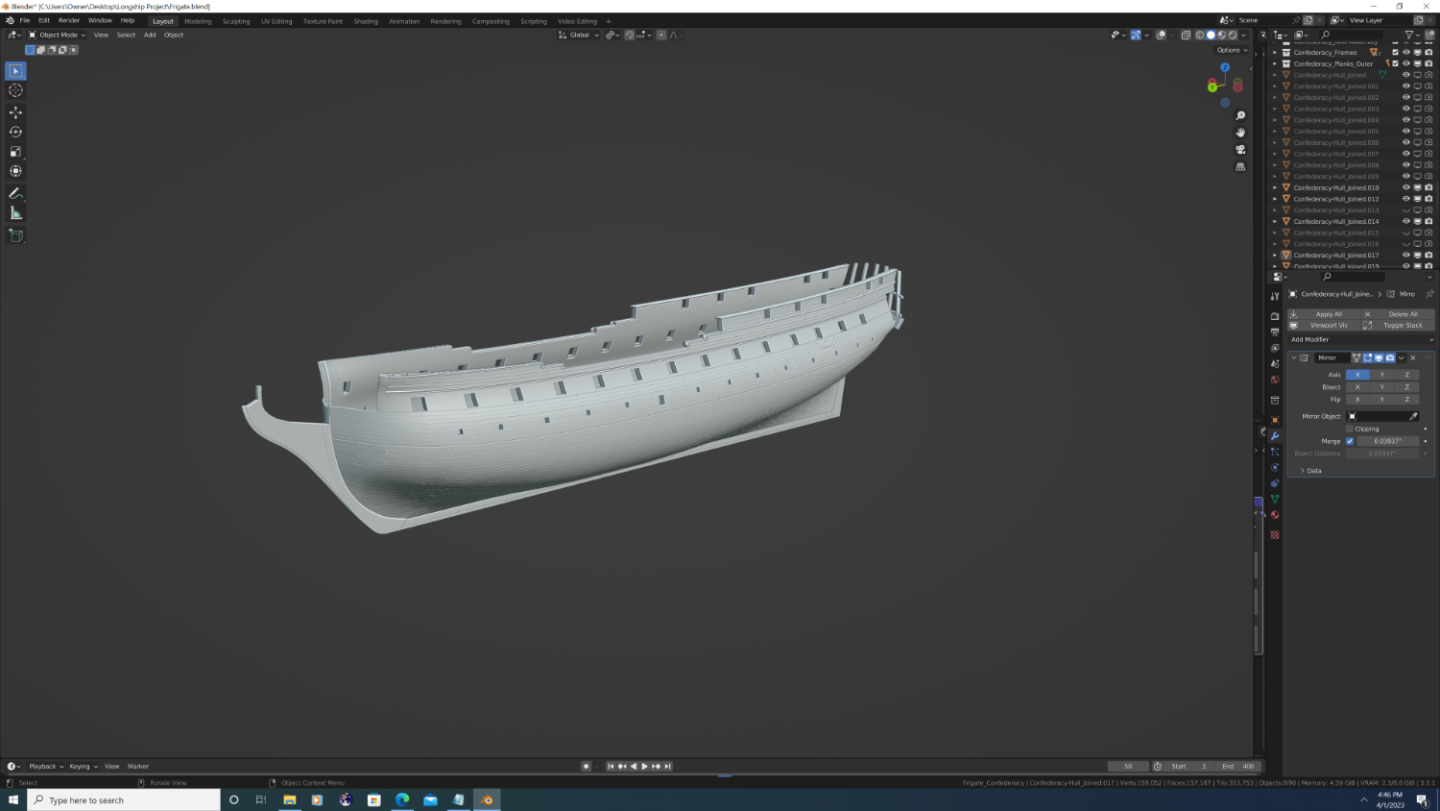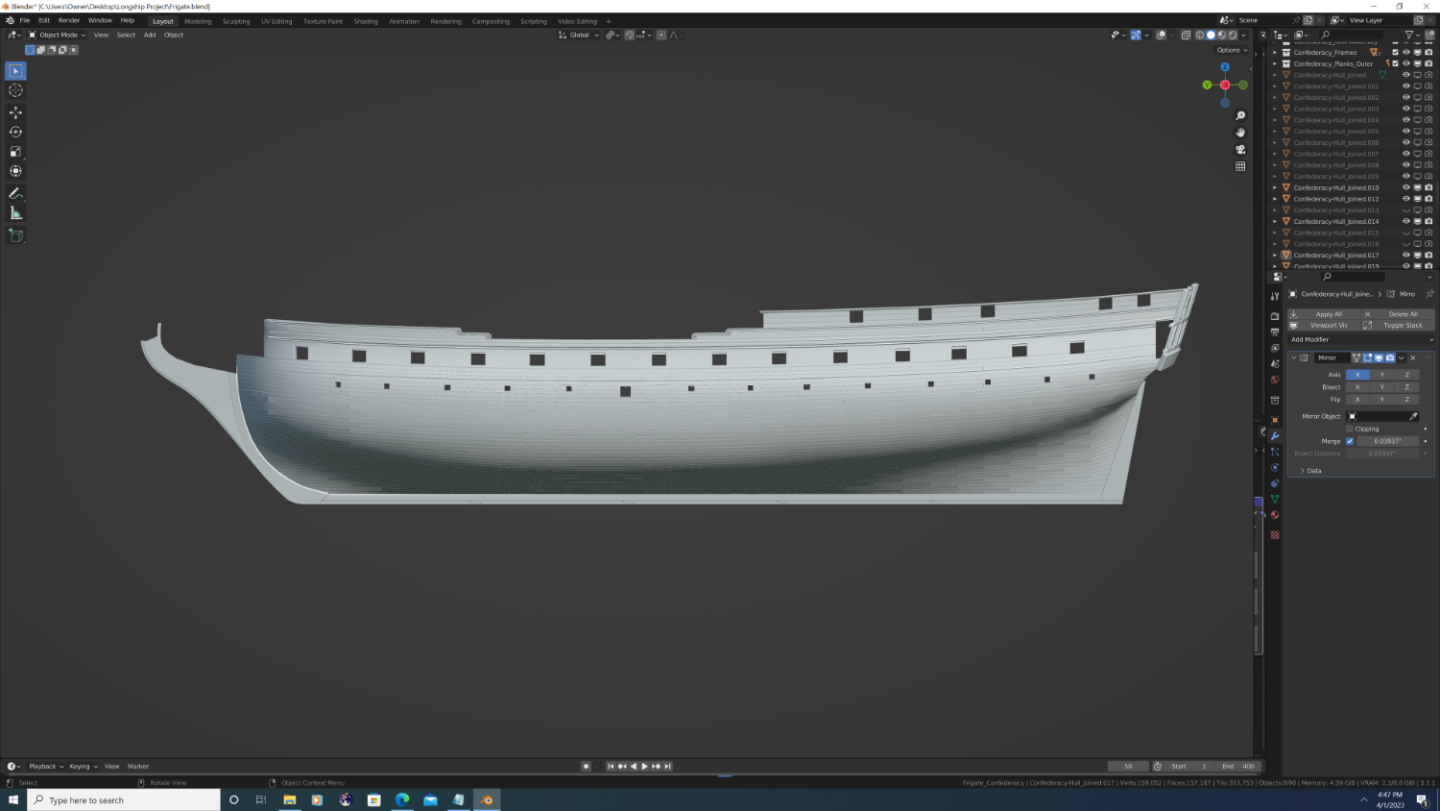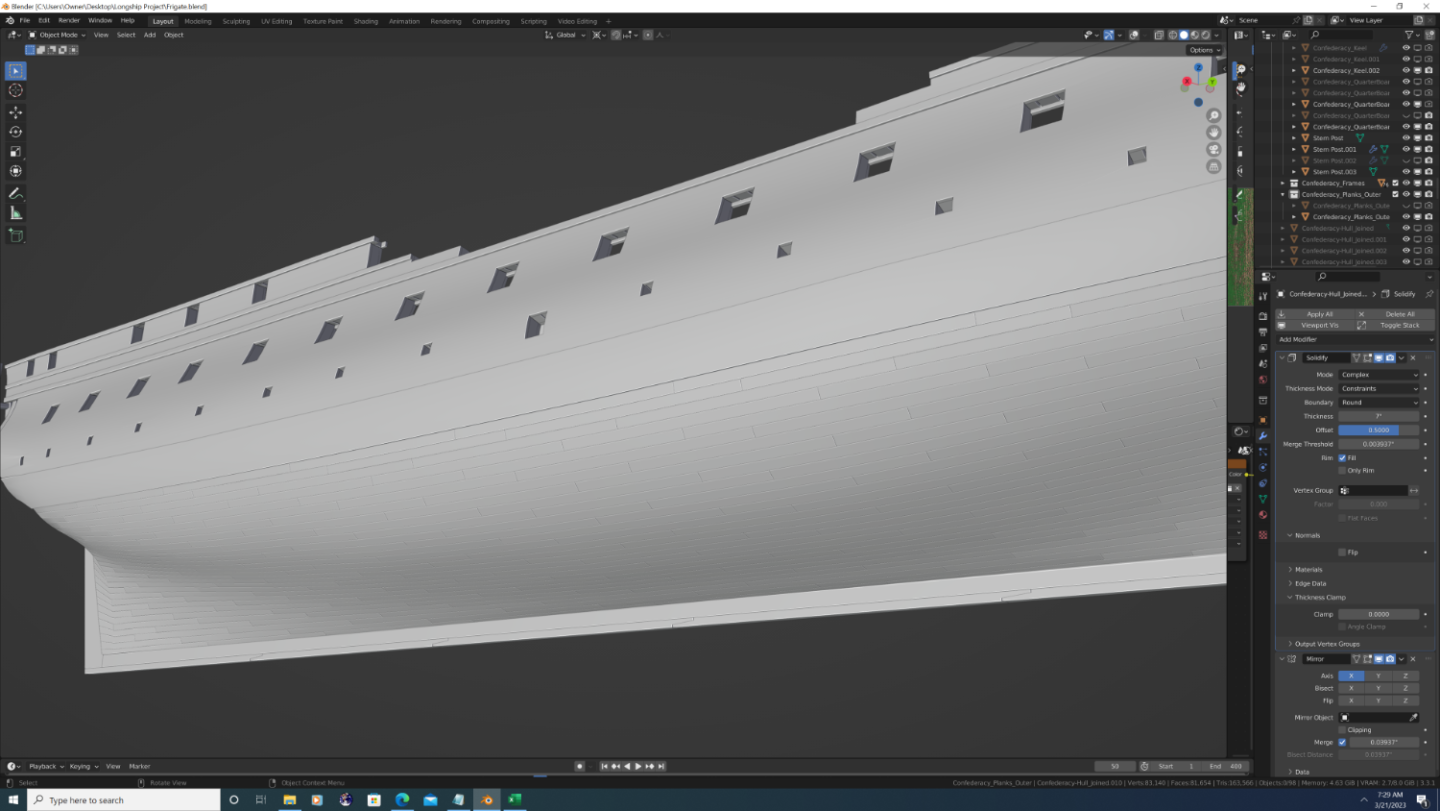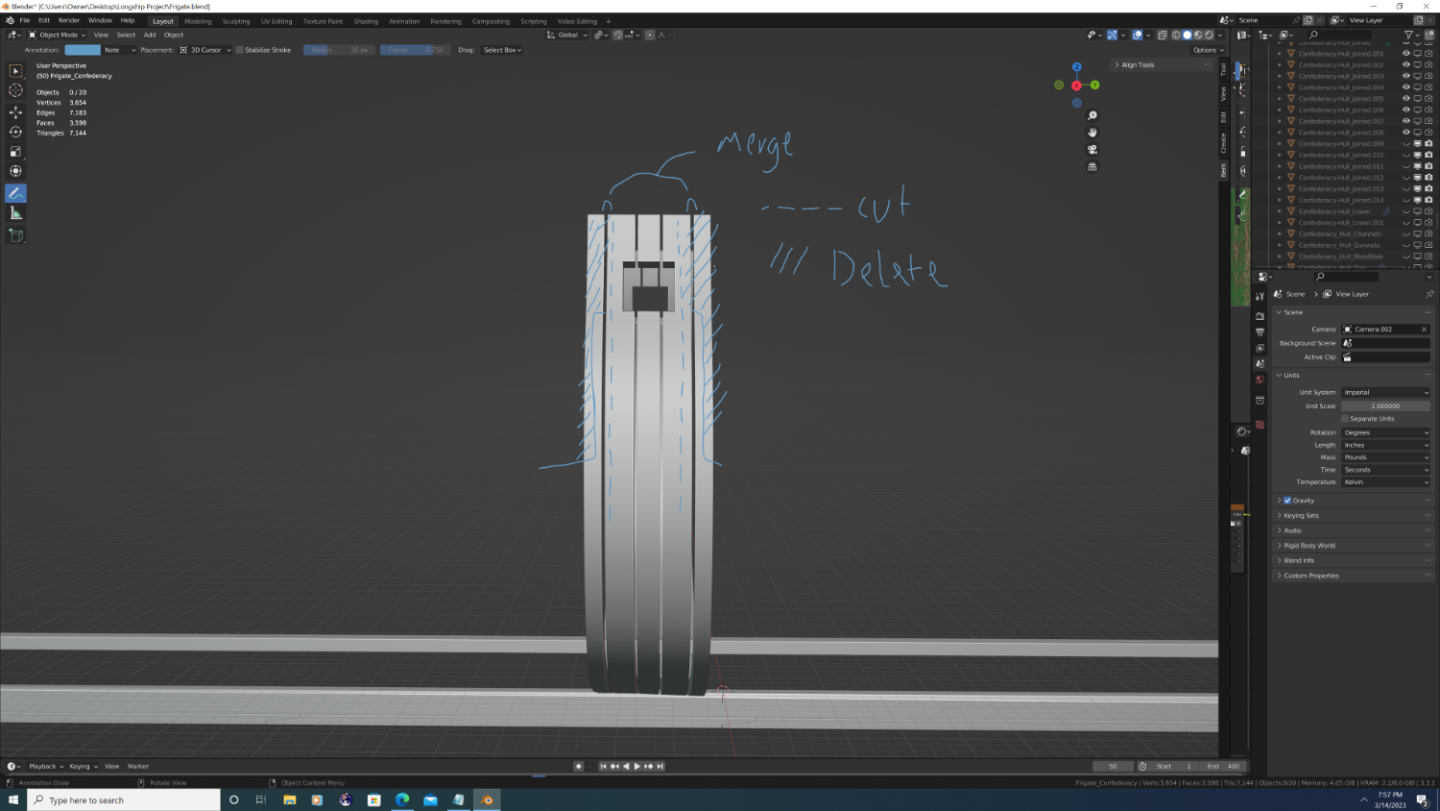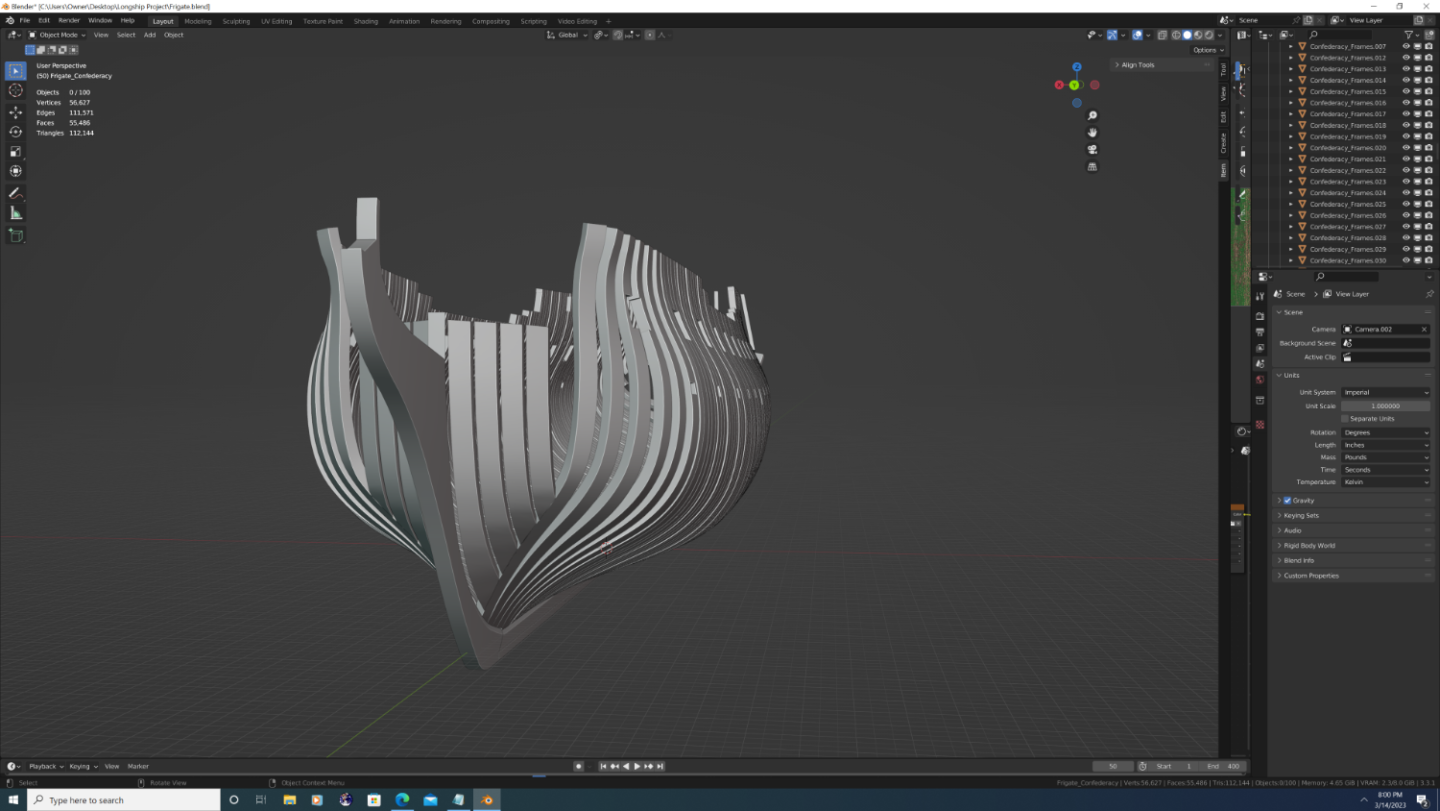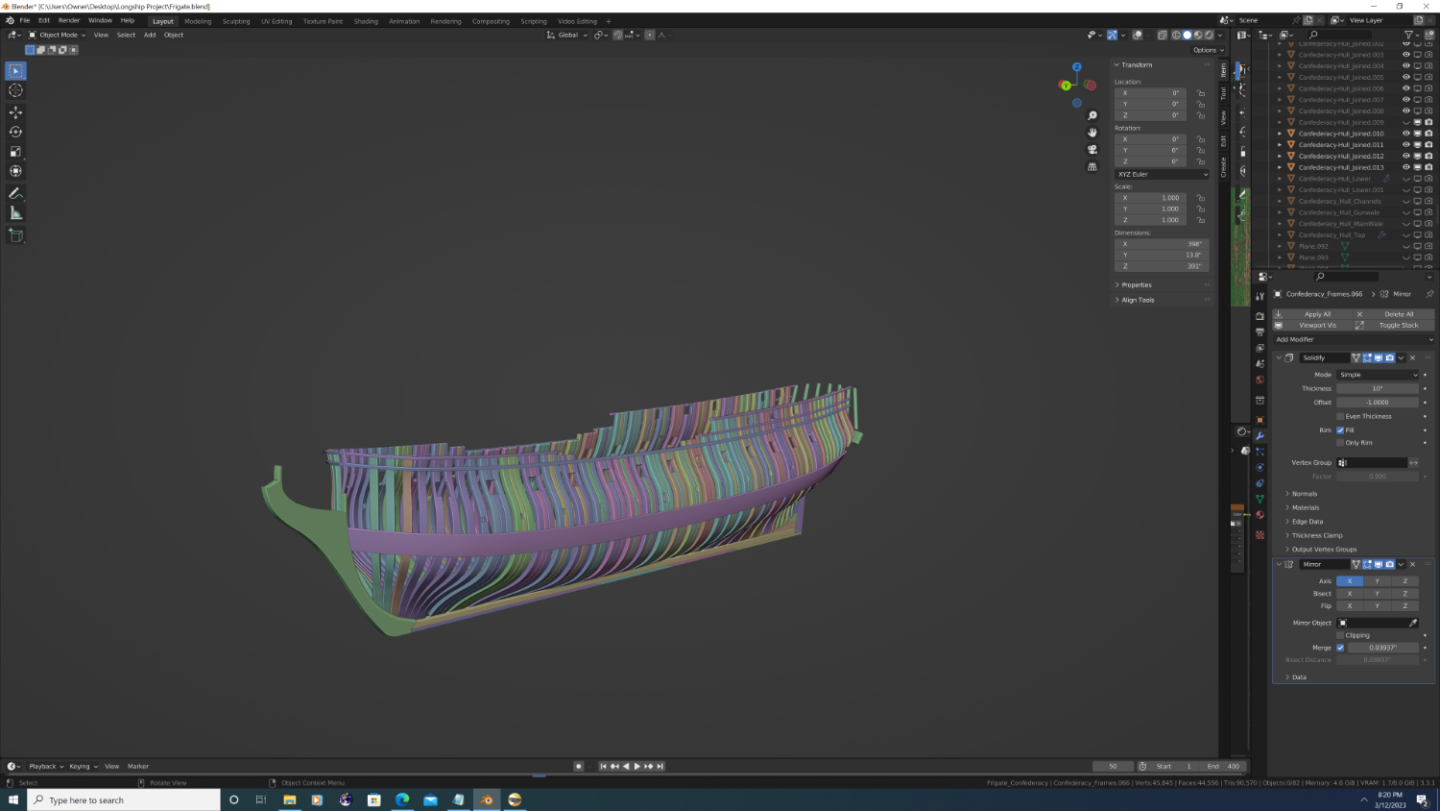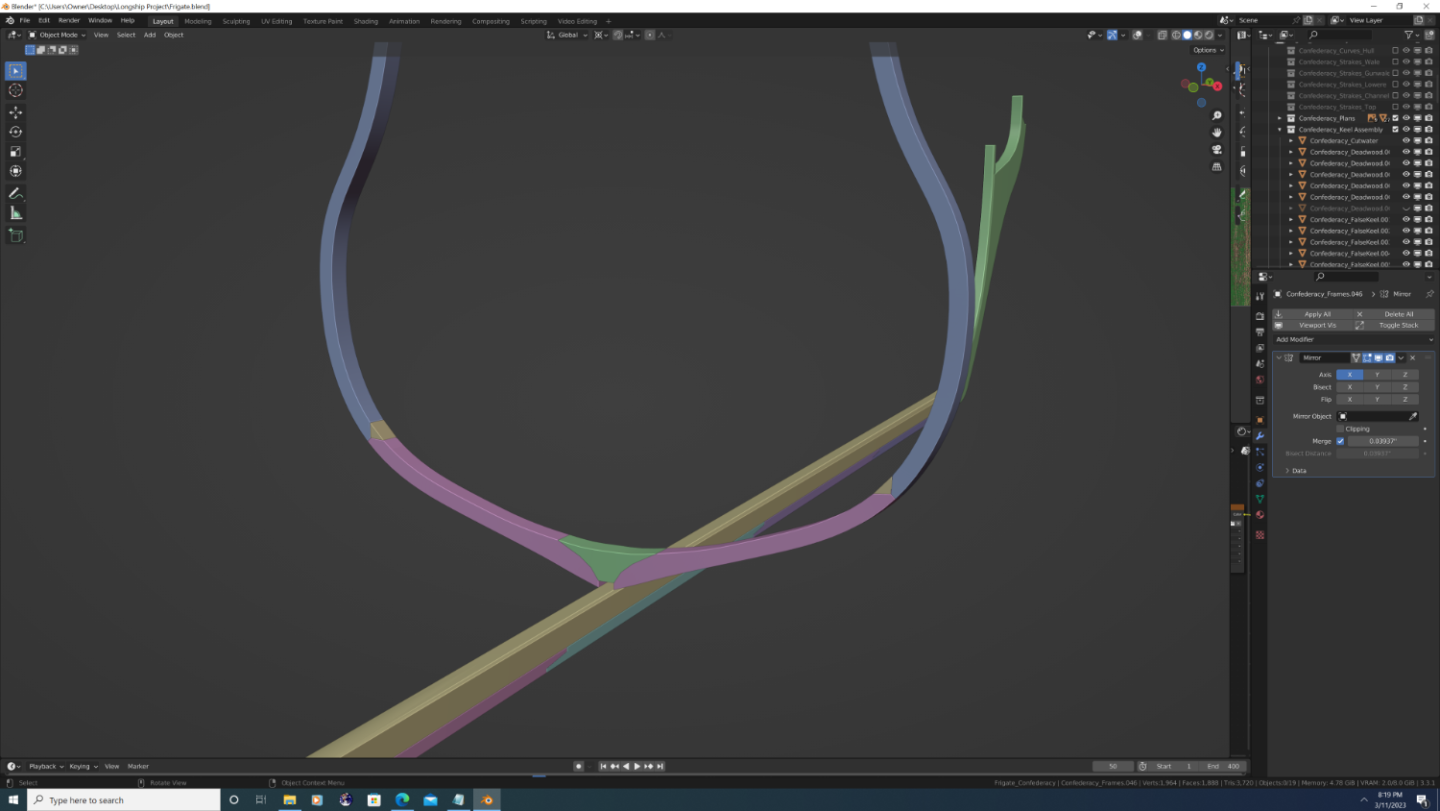
3DShipWright
Members-
Posts
238 -
Joined
-
Last visited
Content Type
Profiles
Forums
Gallery
Events
Everything posted by 3DShipWright
-
Hey Everyone, So it's been a while since I last updated, and I'm pleased to announce the project is progressing, albeit at what feels like a snail's pace. Still, here some of the more noticeable additions/developments: Knightheads modelled and placed Beakneck doors modelled and placed Bobstay separated into its own piece Covers placed atop the roundhouses Seats of ease modelled and placed inside the roundhouses Internal Planking completed from the top of the quarterdeck down through the waterway on the gun deck Breastrail modelled and placed on the aft quarterdeck behind the main mast 'Confederacy' Name displayed across the upper counter at the stern (The U.S. eventually followed suit of the British practice of not attaching, painting, or otherwise displaying a man-o'war's name on its hull, but not until 1785) Channels modelled and placed Glass added to windows Paneling placed behind window framing on the 'false windows' Catheads added with sheaves Headtimbers placed using Bezier curves (minor adjustments required) And now for the screenshots:
- 107 replies
-
- Frigate
- Confederacy
-
(and 1 more)
Tagged with:
-
Okay - gotcha, thx. Yeah, if there's no normal, roughness, specular or bump map data to consider, my question kind of goes out the window lol. Still, it makes your work that much more impressive as at first glance I thought there was that kind of 3D interpolation going on, especially with the cannons on the lower deck(s). Thx again.
-
Looks great Martes! Random question - are you baking multiple textures into a single material for each ship? If so, is this something you have a lot of experience with? I'm ashamed to admit I've been hesitent to get into that part of blender, yet I know its an absolute 'must' if I ever want to do detailed ships in a large scale setting, be it a game, video, or render. Either way, your work continues to impress! -Nate
-
Inviting @wernerweiss and @WalrusGuy as other current Confederacy builders if they'd like to weigh in. So yes, American frigates, specifically the Confederacy - were/was quite different than anything else out there at the time. The 'why' these choices were made is actually kind of ironic. But in historical context, they make perfect sense. A few years back, @mtaylorshared an excellent link to letters of correspondence between Confederacy's shipwright and the Continental Congress that shed light on her design and build. For the life of me, I can't seem to find his post again, so I'm paraphrasing from memory here as well as some inferences I drew from the text: 1. Most 'American' (I'm using quotes because the notion of America as a country was in dispute at the time lol) shipwrights were trained in service of the Royal Navy, but when war broke out, they were cut off from the design resources and structure of the British Admiralty. This was both good and bad. On one hand, they were free to break status quo and experiment with more modern techniques, such as Chapman's works, but also the Swiss mathematicians, Bernoulli and Euler. 2. America had superior lumber (specifically species of live oak and other greenwoods), but inferior or simply less availability to copper. In 1781 the American Navy finally followed suit of the English and mandated that all military vessels be lined with copper. However, that's not to suggest they didn't understand it's importance well before that, and my guess is confederacy was intended to be sheathed. 3. Confederacy can best be described as an overly ambitious project and an un-realized dream. At a time when the American Navy had a grand total of 6 warships and a handful of repurposed sloops, the Confederacy was to be the Flagship of the new nation. She was ornate, featured dozens of hand-sculpted carvings, and was stylized in an Italian sub-set of Neo-classical architecture, known as Palladian style. 4. BUT - not only did she repeatedly run out of funding, when the build inevitably ran over schedule, she was rushed out to sea. So instead of a copper hull, she got one of white oak, poorly painted white. In the cold waters of the North Atlantic, white-bottom hulls could stave off large quantities of marine growth. However, a single trip to the Caribbean, the pesky teledo worm had bored enough holes in her hull that wood rot consumed her greenwood framing within a few months. Finally, instead of 38 large caliber guns and several carronades, she left port with 28, comprised solely of 12pdrs and 6 prds. As I promised my build of her would be as close to historically accurate as possible, I intend to show her [paraphrased] "Prepped for copper but hastily white-washed below the wale, black wale and top-section, red internal planks, a hull above the wale of 'natural ochre', trims of red, white and blue, and carvings of natural wood." That's a surprising amount of color, and means the typical yellow, black and red as seen on the MSW kit is not actually correct, but to be fair, I don't know if those letters were publicly available when they came out with the kit.
- 107 replies
-
- Frigate
- Confederacy
-
(and 1 more)
Tagged with:
-
@Martes - Ah! i see what you're saying now. So I'm not actually sure how that would've been on the confederacy. On the one hand, there was no door to the quarter galleries on Confederacy, just a carve out that went all the way back (very weird, but I verified it. Also confirmed this design feature with other MSW kit builders). Anyway, there was no overlap in the framing which would require those windows to be fake so it could very well have been real glass. The USS constitution is actual glass, and accommodates a seat of ease. That said, it has a much boxier hull, whereas Confederacy looks more like the plan of L'Africane listed above. On the other hand, Confederacy also had near floor-to ceiling windows across the stern (Colonial Palladian Architecture style, a precursor to the federalist style of 1785) which would be tricky to fit a seat of ease. So short answer is I don't know lol
- 107 replies
-
- Frigate
- Confederacy
-
(and 1 more)
Tagged with:
-
@Martes - Interesting... So there's no glass in any of them yet, but are you saying the outer ones are essentially 'open air' windows, or that the framing has a solid wood sheet behind it (as seen on the Black Pearl in the Pirates of the Caribbean movies)?
- 107 replies
-
- Frigate
- Confederacy
-
(and 1 more)
Tagged with:
-
- 107 replies
-
- Frigate
- Confederacy
-
(and 1 more)
Tagged with:
-
Main head rails, cheeks, bolster plates, and the beakneck bulkhead (love saying that, lol) in place.
- 107 replies
-
- Frigate
- Confederacy
-
(and 1 more)
Tagged with:
-
- 107 replies
-
- Frigate
- Confederacy
-
(and 1 more)
Tagged with:
-
I've got the general 'stencil meshes' for the upper/lower counters in place. A couple errors to be sure, but by and large a vast improvement over the original version I did, for which I basically said "screw it" and just randomly shaped the mesh until it was smooth. All the pretty decoration and textures will come later, but you gotta build a house (or an 18th Century frigate) on a sturdy foundation... something I didn't do the first time around... Here's two comparative shots just for fun: New Version (so far): Old Version:
- 107 replies
-
- Frigate
- Confederacy
-
(and 1 more)
Tagged with:
-
Actually, Looking more closely at your model, I think the middle of your sails is billowed believably - its just the edges that look wrong. I would add the side edges of your sail mesh to the pin group you used in the cloth simulation, but at a low vertex weight. I think I used 20% for the outer edges and 10% strength for where the buntlines fall on the sail (on the sails that have buntlines, that is). Doing so will also give you that iconic 'segmented' look.
-
Hey Kurtis, Sorry for any confusion. There are two reasons behind my comment, but they may or may not apply to your model: 1. The braces can interfere with the sail just above its belaying point on the mast (see screenshot). In real life, you'll notice the bottom edge of certain sails will fall over the occasional brace or stay. If you do the braces first, you can use them as collision objects to achieve this effect... 2. If hardware performance is a concern and you have to make sacrifices, favor the running rigging to the yards over details on the sails... I've seen hundreds examples on CGTrader and TurboSquid where the artist favored the sails and neglected the lifts, halyards and braces. When they do this - no matter how good the sails look - the result always feels cartoonish and hollow (IMHO). If you can do both - Great! But I promise you, Braces and Lifts are far more important overall than modelling individual gasket and gromet ties. Other than that your approach is correct. When it comes to how sails interact with the gear rigging: Do any physics simulations on the sails first, apply the modifiers, then duplicate the sails to derive the curves of the lines that interact directly with the sail. Also keep in mind that on a ship of the line, the combined surface area of cloth is in excess of 40,000 square-feet! Ultimately, that makes each sheet extremely heavy, and unless your ship was in the middle of a hurricane, there's no way the sail could be that billowed out.
-
Hey Kurtis, Good update overall. So it's your decision of course, but I'd strongly recommend you pause work on the sails until you have the main components of the running rigging completed. So you know, most real-world sailors and historians I've watched or have spoken with compartmentalize rigging into three categories: Standing Rigging - The Standing Rigging structurally supports the Masts and Bowspirt. Includes the Shrouds, Stays, Backstays, Preventer Stays, Channel Ties, Crow's Feet, etc. plus some hardware such as the Deadeyes (plus lanyards), Chain Plates, and a few other misc. items. You have this modelled/installed for the most part so I won't dwell on this part Running Rigging - The Running Rigging is the set of lines used to move the Yards. These are the Braces, Lifts, Halyards (slings for the course yards), Throat Halyards (with parrels). This is where I'm suggesting you focus next, if possible. The 'Gear' - While technically part of the running rigging, the Gear is a layman's term used to differentiate the rigging that controls the Sails themselves. Includes the Buntlines, Bowlines, Clewlines, Sheetlines (Sheets), Tacklines, and Reef Tackles. While this is important in real-life, in a 3D model, you can omit much of this and still have a convincing ship Hope this helps, keep up the great work. P.S. Maybe I missed it, but had you landed on a final color/texture scheme yet? Just curious... -Nate
-
Well, it's been 1 month to the day since I started Confederacy. Framing 90% Complete Outer planking of the main hull complete! Starting the Quarter Board and Quarter Piece.
- 107 replies
-
- Frigate
- Confederacy
-
(and 1 more)
Tagged with:
-
@Martes - The algorithms have improved, yes, but to your point they are not without fault. Not sure if this will make sense, but what is missing is the ability to solidify while locking a specific axis. Here's a perfect example: Take a look at the framing of the stern, specifically the counter and quarter piece timbers above the wing transom... These frames should have even thickness along the curve of the lower counter, which they do, but also extend straight forward. However, they actually move towards the centerline because the back of the mesh is arced because the quarter board is arched. Blender doesn't have a good answer for this. As a fix, I will end up deliberately over widening the front edges, then using the knife tool with x-ray on to cut these edges in line with the backs of each frame, but it's a huge pain lol
- 107 replies
-
- Frigate
- Confederacy
-
(and 1 more)
Tagged with:
-
@Martes - Good eye! Actually, that notch has nothing to do with the modifier, it's an intentional marker I made to notate the start of the stepped scarf for the cant frames and the transition of the rabbet of the keel to the rabbet of them stem. I will remove it once I flush out the detail of the gripe and boxing joints
- 107 replies
-
- Frigate
- Confederacy
-
(and 1 more)
Tagged with:
-
@Martes - Hey Martes, So I don't know whether to call it procedural or manual, but here is how I'm doing hull planking on Confederacy: 1. The underlying topology of the ship has to represent the outer planking to begin with. Refer to the steps at the beginning of this topic for instructions on how I got the underlying topology to match the planks if you're curious. 2. In edit mode use 'mark seams' to visually outline the strakes, then the shape of each plank on the 2D mesh. Edge loop select makes this faster than you might think, I did the whole ship in under 15 mins NOTE: I'm only showing the bottom of the hull for tutorial purposes, but the rest of the planking works the same way. 3. Use the solidify modifier to add thickness as desired, HOWEVER, DO NOT FILL THE RIM. Apply the modifier to get two separate 'sheets'. 4. In face select edit mode, press 'L' to highlight the front and backs of each plank and separate them using 'P'. You can do this in groups of planks as long as they're not touching 5. Go to each separate plank set object, edge select in edit mode, and choose select boundary loops. 6. Then you can bridge edge loops together, just make sure 'Loop Pairs' is selected. 7. Finally, join everything back into one object and change the 'Transform Pivot Point' to 'individual origins' Go into edit mode, select everything and press 'alt+s' then '-.1' to shrink each island along the normals by .1 inches (or whatever value looks good in metric units, just keep it small)
- 107 replies
-
- Frigate
- Confederacy
-
(and 1 more)
Tagged with:
-
Outer planking nearly complete. Rough tree rail complete. Caprails apart from the forecastle are finished. Trim pieces nearly finished. Mouldings will be fine-detailed later to a cohesive style. For anyone interested, the planking offsets from the hull frames are as follows: Rabbet to Wale: 3in Wale stringers: 5in Wale Hook-and-Butt blocks: 4in Top of Wale to Gun Deck Clamp (inboard on the Confederacy): 3in Gun/Channel Plate/Scuppers Wale: 4in Planking above Gun/Channel Plate/Scuppers Wale: 3in Channel Stringer: 5in Quarter Deck Stringer & Forecastle Stringer 5in Trim Pieces: +2in, maximum from surface of their respective perch Rough Tree Rail: 15in maximum
- 107 replies
-
- Frigate
- Confederacy
-
(and 1 more)
Tagged with:
-
I'm trying out a new method of planking for the Confederacy, and gotta say - so far it's working out rather well. No overlapping geometry and equal gaps between the boards regardless of the twist of the hull...
- 107 replies
-
- Frigate
- Confederacy
-
(and 1 more)
Tagged with:
-
@Martes Yep, good call and that's precisely what I'm doing now. I've added all filler frames aft of the bow cant frames and before the stern cant frames. I actually added narrow filler frames to sandwich in each pair of double around the ports. I'll end up joining these 'narrow' filler pieces with their neighbors and resplicing them to create the true doubles look, but even now the ratio and overall frame plan feels way better than it did before. Finally, I've added the hawse pieces and cut them short to accommodate the bow deck (name?). I'm keeping the cant frames from the 45-90 degree radials, but I will thicken and nudge them back on one another to form a more authentic shape and close in some gap space.
- 107 replies
-
- Frigate
- Confederacy
-
(and 1 more)
Tagged with:
-
- 107 replies
-
- Frigate
- Confederacy
-
(and 1 more)
Tagged with:
-
@Martes And yes, I agree and will put additional framing between the ones I already have
- 107 replies
-
- Frigate
- Confederacy
-
(and 1 more)
Tagged with:
-
@Martes All true, you're just jumping the gun a bit... Here, I went ahead and did a mockup of one of the frames as I want them all to look when I'm done framing.
- 107 replies
-
- Frigate
- Confederacy
-
(and 1 more)
Tagged with:
About us
Modelshipworld - Advancing Ship Modeling through Research
SSL Secured
Your security is important for us so this Website is SSL-Secured
NRG Mailing Address
Nautical Research Guild
237 South Lincoln Street
Westmont IL, 60559-1917
Model Ship World ® and the MSW logo are Registered Trademarks, and belong to the Nautical Research Guild (United States Patent and Trademark Office: No. 6,929,264 & No. 6,929,274, registered Dec. 20, 2022)
Helpful Links
About the NRG
If you enjoy building ship models that are historically accurate as well as beautiful, then The Nautical Research Guild (NRG) is just right for you.
The Guild is a non-profit educational organization whose mission is to “Advance Ship Modeling Through Research”. We provide support to our members in their efforts to raise the quality of their model ships.
The Nautical Research Guild has published our world-renowned quarterly magazine, The Nautical Research Journal, since 1955. The pages of the Journal are full of articles by accomplished ship modelers who show you how they create those exquisite details on their models, and by maritime historians who show you the correct details to build. The Journal is available in both print and digital editions. Go to the NRG web site (www.thenrg.org) to download a complimentary digital copy of the Journal. The NRG also publishes plan sets, books and compilations of back issues of the Journal and the former Ships in Scale and Model Ship Builder magazines.

.png.20a25754c11106924b121204a026f74f.png)
.png.2c2cdef17872ed821ad16b0bf8278969.png)
.png.9ff469f6d0aeb93daeefe207ac9003ef.png)
.png.86481d2c34d367678373c13e98fc50ad.png)
.png.e870420c22e96b9fe9e4d71b31cffa0e.png)

